Cruise Ship Engine Room (Everything You Want to Know)
Disclosure: This post may contain affiliate links. We may receive compensation when you purchase via my links at no cost to you. See my disclosure for more information.
Cruise ships require a lot of power to sail and operate. The cruise ship engine room is both mysterious and fascinating because it’s hidden from passengers.
Passenger ships have come a long way from sails and steam engines. Modern cruise ships use diesel-electric engines, while newer cruise ships are moving towards more environmentally friendly solutions like liquified natural gas.
Here’s everything you need to know about a cruise ship’s engine room.
Table of Contents

Where is the Cruise Ship Engine Room?
The engine rooms on cruise ships are located on the lower decks, between the midship and the aft. The engines aren’t quite at the back of the vessel but closer to midship.
There are several reasons for keeping the cruise ship engine room away from passenger areas.
- Stability : Placing the engines and heavy equipment below sea level helps keep the ship stable and prevents cruise ships from tipping over .
- Noise : Engine rooms are extremely noisy. Naval engineers compensate by incorporating sound reduction features and noise dampeners. However, the sound and vibration wouldn’t be pleasant for cruise ship passengers.
- Security : The engine room spaces are in crew-only areas for safety and security purposes.
Most of the heavy machinery on a cruise ship is located on the lower decks, just above the keel. The positioning of the engine room, other machines, and technical equipment give the massive vessels a lower center of gravity.

Although you might envision the engine room as a massive open room running the ship’s length, the lower decks are divided into several water-tight compartments. One compartment may house the cruise ship water fresh water systems , another for the main engines, and another for the air conditioning.
The division of the engine room into separate compartments is for safety. Dividing the engine room into different containers makes it easier for the ship to contain the damage if there’s a fire or leak in the hull.
Cruise ship fuel tanks are also on the lower decks, but they are kept separate from the main engines.

Crew members can monitor the ship’s systems from the engine control room. From the operation control center, crew members monitor the ship’s systems and act as a central area for maintaining the technical equipment on the cruise ship.
Every piece of equipment can be monitored from the engine control room to ensure the cruise ship runs smoothly.
The room is monitored 24/7 by watchkeeping teams. Each crew member is assigned specific machinery. For example, one person may be responsible for the freshwater generators and water pumps and another for the fuel oil systems.
How Big is a Cruise Ship Engine?

A cruise ship engine room spans several decks and holds the ship’s engines, fuel tanks, water systems, generators, control room, engine workshop, air conditioning, and other essential navigation systems.
Modern diesel-powered cruise ships have between four to six medium-speed (500 revolutions per minute) engines . Each engine can generate upwards of 25,000 horsepower or nearly 18.5 megawatts.
The engines on a cruise ship can be up to 45 feet long, 27 feet high, and weigh up to 275 tons .
These massive engines can propel cruise ships at an average speed of 18-22 knots .
Cruise Ship Engine Technology
Cruise ship engine technology has evolved from wind and sails to newer liquified natural gas technology.
We’ll cover some of the most popular technologies used by cruise ships.
Steam Engines

When the cruise industry began in the mid-1800s, vessels were propelled by steam engines.
Steam engines had boilers that used wood for fuel. Later steam engines used coal.
The boiler produced steam which created pressure in a pressurized system. The pressure moved pistons which drove the propeller shaft.
The Titanic was powered by two huge triple-expansion steam engines and a small propeller. ( Source )
Diesel Engine s

Diesel engines propel most modern ships. Cruise ships may have four to six medium-speed (500 rpm) engines producing 8-10MW each .
Diesel engines work on the same concept as steam engines. Rather than steam, the ignition of diesel fuel pushes the pistons up and down, turning the crankshaft attached to the propeller shaft.
Many of today’s diesel-engine cruise ships also employ a shaft generator to generate electricity for shipboard services, like lighting.
A shaft generator converts the circular motion of the propeller shaft into electricity. However, shaft generators only operate when the ship is moving. And can’t generate electricity while docked in port.
Diesel-Electric Cruise Ship Engines

Almost all new diesel-powered cruise ships use diesel-electric engines.
The engines work the same as a traditional diesel engine, but rather than connecting to the propeller shaft – diesel-electric engines connect directly to large generators .
A diesel-electric engine has one job, generating electricity.
The electricity produced by the engine is used to power the ship’s propellers.
These engines provide greater efficiency than traditional diesel engines.
While connected to a generator, the engines can run at their most efficient settings regardless of the travel speed . Whether the ship is sailing at 10 or 20 knots, the engines can operate a peak efficiency.
Diesel-electric engines are popular because of their ease of control, low noise, minimal vibration, and relatively compact size compared to other forms of propulsion.
Marine vessels that run on diesel power must carry exhaust-treatment systems and catalytic-reduction equipment to reduce the environmental impact of the ship.
Gas-Turbine Power System

Royal Caribbean Group was the first company to experiment with gas-turbine systems.
Compared to diesel engines, gas turbines offer several advantages, including:
- Lower environmental impact.
- More reliable.
- Take up less space.
- Gas engines require a smaller maintenance crew and less inventory.
The heat generated from the engine is recovered and used to produce electricity for other onboard systems, such as air conditioning and water heating.
Despite their advantages, gas propulsion is not widely used in the cruise industry. Gas-powered ships are faster, but most cruise ships don’t travel faster than 22-25 knots .
Diesel engines have greater fuel efficiency at slower speeds , and the high gas price compared to diesel makes them more costly to operate.
LNG Powered Ships

Many new cruise ships are propelled by liquified natural gas (LNG).
LNG is the cleanest fossil fuel currently produced. According to Cruise Critic , LNG-powered cruise ships can “reportedly reduce sulfur emissions by as much as 99 percent and nitrogen oxide emissions by up to 85 percent.” LNG can reduce carbon emissions by up to 20 percent .
The special engines of LNG-powered cruise ships use natural gas cooled to approximately -260°F. Once cooled, the liquid form of natural gas is about 600 times denser than natural gas , making it easier to transport.
Carnival Cruise Line announced the first LNG-powered vessels in 2015, using a “dual fuel” design. The ships can burn both liquified natural gas and marine fuel, reducing the required fuel storage space.
AIDAprima became the world’s first LNG-powered cruise ship on her debut in 2016.
Natural gas is purer, cleaner, more efficient, and cheaper than other fossil fuels . But it’s a relatively new technology, and not all ports have the facilities for refueling LNG-powered ships.
Because natural gas burns cleaner than other fossil fuels, the engines require less maintenance. But LNG has a lower fuel density than diesel, so LNG vessels need fuel tanks that are twice the size.
Emergency Generators
Every cruise ship has an emergency generator to maintain vital electrical power in case of engine failure.
The emergency generators are located away from the main engine room, usually on a higher deck. Their location isolates them from catastrophic damage in the engine room (for example, a fire).
The generators can operate critical navigation systems, emergency lights, and other vital equipment. But emergency generators can’t power the ship .
Larger ships may have multiple emergency generators. But due to the size constraints, they can’t produce the same power as the main engines and cannot propel the ship.
What happens if the generator fails?
Cruise ships have several redundant systems to ensure the safety and security of passengers. If the generators fail to work during an emergency, cruise ships have an emergency battery backup to power the most critical systems for up to 24 hours .
Shore-to-Ship Power Supply
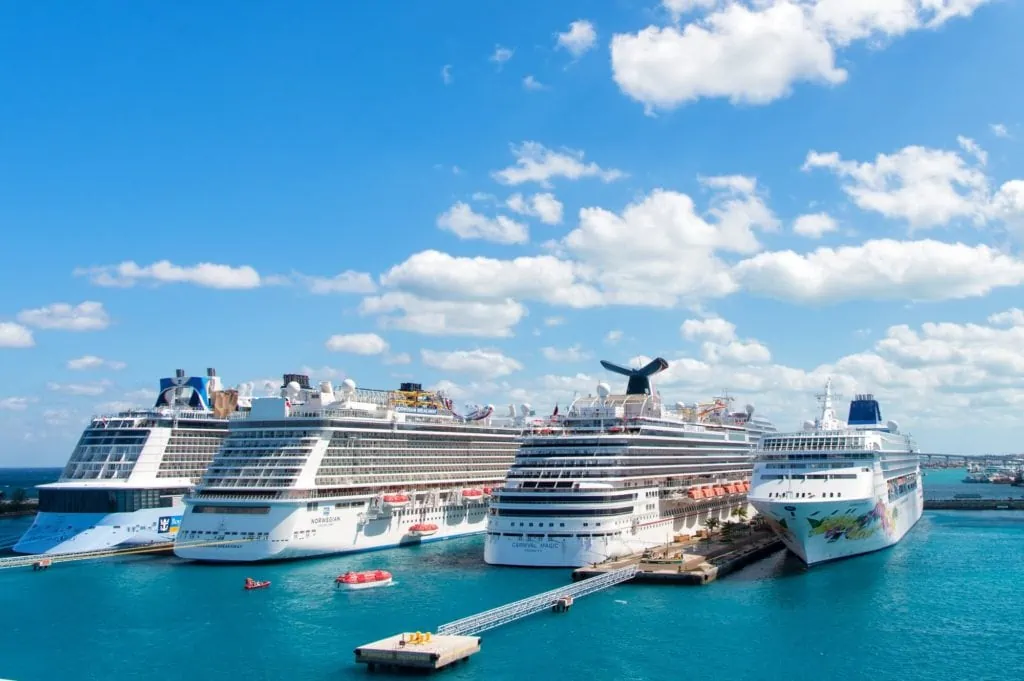
Despite innovations in engine technology, cruise ships produce a lot of pollution.
To further reduce ships’ environmental impact, many cruise ships can connect to the cruise port’s power grid , known as “shore-to-ship power” or “cold ironing.”
In the past, cruise ships kept their engines running while docked to generate electricity for shipwide services.
But most of the energy produced by the ship’s engines goes towards powering the propellers, and running the engines while docked created massive energy waste.
Some cruise ships used smaller generators to power the hotel and amusement functions. The smaller generators allow cruise ships to shut off the main engines in port, reducing pollution.
Modern cruise ships are equipped with systems to “plug in” to the local power grid. Even some older cruise ships are being retrofitted to allow for shore-to-ship power.
Not all cruise ports have facilities to enable shore-to-ship energy. But many larger cruise ports have dockside electrical hookups that allow cruise ships to shut off their engines and run on the city’s electrical grid. The technology reduces harmful emissions by up to 95% while ships are docked .
Considering how much time cruise ships spend docked at port, it significantly reduces sulfur and carbon emissions.
How Loud is the Engine Room of a Cruise Ship?

A cruise ship engine room is incredibly noisy, exceeding 173 decibels . At this noise level, the noise in an engine room can cause immediate damage to your hearing without proper ear protection.
For reference, a gunshot is 130 decibels.
Engine rooms have insulation and sound-reducing technology, so it’s not as noisy. To prevent hearing damage, crew members must wear hearing protection when entering the multi-story engine room.
But guests don’t have to be concerned about the noise.
Thanks to the insulation and sound dampening, you’ll only hear a slight “purr” if you’re near the engine room.
You may feel the engine’s vibration if your cabin is on the lower decks, near the aft . On most ships, the noise isn’t enough to cause any annoyance or trouble sleeping.
But if you’re a light sleeper, accommodations near the engine room are among the worst cabins on a cruise ship .
Where are the Fuel Tanks?
The fuel tanks are located below the passenger decks , near the engine room. The fuel is stored in double bottom tanks.
How Much Fuel Can a Cruise Ship Hold?
A large cruise ship of 1,100 feet in length can hold between 1 to 2 million gallons of fuel .
It’s enough to power the cruise ship for up to two weeks of sailing without refueling.
Are There Cabins Near the Engine Room?
Newer cruise ships have a large gap between the cruise ship engine room and passenger cabins to minimize noise and vibrations.
However, you may still find cabins reasonably close to the engine room.
If you book a cabin near the engine room, you can expect to hear some noise and feel the vibrations caused by the engines . However, cruise ships use sound-dampening technology and insulation to minimize noise pollution.
The engines are typically cheaper because most passengers avoid booking cabins next to the engine room.
Cabins near the cruise ship engine room aren’t noisy enough to cause annoyance or sleeping issues.
If anything, the vibrations caused by the engines are more likely to cause annoyance over the sound of the engine .
How Much Fuel Do Cruise Ships Use?
It takes a lot of fuel to power a cruise ship.
The average cruise ship uses around 18.3 gallons of fuel per minute or 1100 gallons per hour . ( Source )
Marcello De Lio
Leave a Reply Cancel Reply
Your email address will not be published. Required fields are marked *
Name *
Email *
Add Comment *
Save my name, email, and website in this browser for the next time I comment.
Post Comment
This site uses Akismet to reduce spam. Learn how your comment data is processed .
Trending now


The Shipyard
For Those Who Love Ships
- Cruise Ships
How Cruise Ships Work (Part 3): The Bridge and the Engine Room
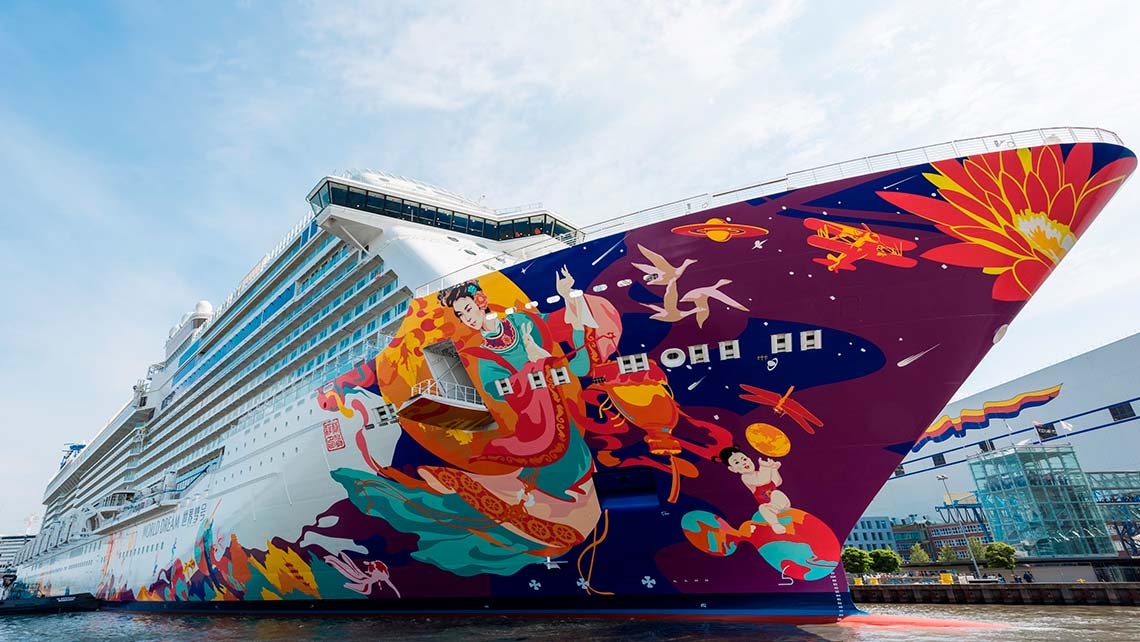
It’s like back in the days when we were little children. Grandpaw’s almost mystical tool shed was strictly off limits, but we were just dying to have a peek, weren’t we? Now that we are all grown up, Grandpaw’s gadgets are old news, but there is still a place or two on a cruise ship that remains like a pie in the sky for all of us obsessed by ships.
It’s the heart of the matter, it’s where it all happens, it’s the real deal. And if you are anything like me, you would gladly give away a day at the spa, a dessert buffet and even two, or the latest Marvel flick in the movie theater, just to spend a precious hour down in the noisy engine room of your favorite cruise ship. But life being proverbially unfair, modern cruise lines rarely allow their passengers to enter the bridge or the engine rooms of their ships, unless the visit is part of a specially organized guided tour. Some cruise ships have a window from which passengers can observe what’s going on in the bridge, but only if they promise not to disturb the officers. Which is really hard, when you badly want to touch everything…
So until the next time someone lets me out of sight and I make my umptieth attempt at trespassing to the engine room, let’s have a quick virtual tour of a cruise ship’s most forbidden and exciting parts.
The bridge is the brain of the ship. It is from there that the captain and his officers command and maneuver the ship, keep watch for other vessels or potential hazards, and navigate through the oceans.

For twenty-four hours each day, the bridge is occupied by two Deck Officers and two Able Seamen, traditionally in four-hour shifts. The main job of the Officer of the Watch is to monitor the ship’s systems and surroundings, and to ensure that everything is running safely and smoothly. During extreme weather, docking, or other special cases, the Captain of the ship is also present on the bridge to guide the deck officers.
The term “bridge” comes from the time of the paddle steamers, where a bridge was built above the two paddle houses that used to hold the paddle wheels. This way the skipper could observe both wheels, while moving freely between the two and giving out commands. On today’s cruise ships, the bridge is usually on the upper deck in the forward part of the ship and extends over the sides of the superstructure, allowing deck officers a view to the sides of the ship as well as down to the waterline. The side extensions are called bridge wings and often have a glass flooring for better visibility.

The bridge houses a number of important nautical devices and information systems for command and navigation of the ship.
Satellite Navigation
The signals emitted by special navigation satellites are picked up by the cruise ship through a special antenna. On board, a computer converts these signals into the exact position of the ship at a given time. On large ships, the position indicator is constantly recorded in a so-called electronic nautical chart.
Satellites also enable automatic positioning systems on modern cruise ships. The positioning system is controlled from the bridge and it uses GPS to ensure that the ship stays at a defined location. When the captain defines a position where the ship needs to remain for a while without anchoring, the system automatically maintains the ship in position by using the bow and stern thrusters.
Modern cruise ships carry a gyro compass and a magnetic compass. The gyro compass consists of a fast-rotating disk, usually positioned in a gimbal. It is a non-magnetic compass oriented parallel to the axis of rotation of the earth and thus indicates the north-south direction.

The gyro compass is more accurate and reliable than the magnetic compass and is therefore the primary reference point for steering the ship. The magnetic compass on board is more prone to inaccuracies and it serves only as back-up.
The word radar stands for Radio Detection And Ranging. Radars are devices that allow us to locate distant objects from a given location, regardless of visibility and weather conditions. The radar emits electromagnetic waves to an object, then receives back the reflected echoes from that object, and interprets them based on distances and angles. These interpretations enable us to determine where an object lies, and in some cases even what its contours look like. In the shipping industry, radars are used for monitoring traffic in ports and coastal regions, for collision protection, for collecting weather data, and for navigation.
Speed logs are devices that measure the speed of the ship. There are two main types of speed logs: Doppler logs and electromagnetic logs.
The Doppler logs send out underwater sound signals. When the sound wave reaches the sea floor, it gets reflected and then returns to the receiver of the log. Due to the movement of the ship relative to the seabed, a Doppler effect occurs and is evaluated by the device. As long as the sound waves can reach the bottom of the sea and return to the receiver, the Doppler log measures the distance travelled over ground. However, if it is no longer possible to use the seabed as a reference, the device uses particles suspended in the water, such as plankton and minerals, to measure travel through the water.

The electromagnetic logs create an electromagnetic field in the water around the ship, with the aid of a small alternating current and a transducer. A voltage proportional to the speed of the ship is generated in the water and is picked up by special sensors, which then transfer the information to an electronic device for interpretation. From the electronic device, the speed is then transmitted onto the displays in the bridge.
Echo Sounder
Cruise ships also have an echo sounder, a device used for the electro-acoustic measurement of water depths (sounding). The depth is determined by measuring the time between the emission of a sound impulse (water sound) and the arrival of the sound waves reflected from the bottom of the sea. The main purpose of echo sounders in cruise ships is safe navigation through waters.
Electronic Chart Display and Information System
The Electronic Chart Display and Information System (ECDIS) is a console, built into the bridge of modern cruise ships, which incorporates the main engine safety system, fire control system, monitoring and control system, power management system, propulsion control system and navigation and maneuvering system. The ECDIS allows for navigation of the ship without the need of traditional paper charts. Navigation can be done manually, automatically, or through the Navigation and Command System (NACOS).

The NACOS is the main software used to coordinate all factors that need to be taken into consideration, in order to navigate and maneuver the ship safely. The console is composed of a number of displays showing information from the radars and compasses, data about the course of the ship and planned maneuvers, the current status of the pitch of the thrusters, the speed of the ship, and anything else concerning the steering of the ship. An intelligent autopilot tracks changes in the behavior of the ship through navigational sensors. If the ship drifts off its course due to strong winds, for example, the system automatically responds to correct the change by sending signals straight to the engine room. Once the signal is received by the engines, the rudder or thrusters of the ship are activated and move to the position given by the system. The displays on the bridge show both the angle of the rudder or thrusters, as well as the rate and the radius of the maneuver in progress.
The Engine Room
The engine room is the heart of a cruise ship. It is here that pistons hammer and crankshafts turn to propel the ship forward. It is the loud and oily place where the Chief Engineer and his team work around the clock to ensure that everything is running smoothly. It is the engine room of the ship that allows for the luxuries of air-conditioning, electricity, and plumbing on board cruise ships.

In future articles we will have the chance to explore the contents of the engine room in all the excruciating detail that they deserve, so to all the techies out there – I’ve got you covered. Just stay tuned.
Most larger ships have more than one engine room to house their machinery. The arrangement of the engine room can vary depending on the type, design, and size of the ship. For stability reasons, the engine machinery is typically placed as low as possible in the ship’s bowels and often takes up several decks in height. The machine rooms are split into watertight compartments, each housing different machinery.
Today’s cruise ships operate on diesel or diesel-electric engines. Their operating principle does not differ much from the old days of coal steamers, except for the medium used to generate power. While back in the day ocean liners used steam to move the engine’s pistons, modern cruise ships use diesel fuel. Today’s diesel engines are composed of the engine unit itself, gearboxes, shafts and generators. Some ships also have shaft generators which create electricity from the turning movement of the propeller shaft. The electricity is then used in the cabins, on deck and in the kitchens.

The latest generation of cruise ships are equipped with diesel electric engines. Instead of the more traditional engine-shaft-propeller arrangement, in this case the engines are connected to generators to create electricity. The generators power electric motors, and the electric motors move the propellers.
Aside from the engines and generators, the machinery that occupies the engine rooms includes pumps and heat exchangers for engine cooling, stabilizer fins and their motors, as well as the ship’s bow thruster system.
Since all of the equipment in the engine room is highly dependent on electricity, modern cruise ships also have back-up generators, usually located outside the main engine room, to protect them in case of fire. While these generators cannot produce enough power to keep the ship moving, they produce enough to keep some of the vital functions of the ship running, such as powering the emergency lights and the communication and navigation systems. In case the back-up generators fail, cruise ships are also equipped with a back-up battery that allows some of these functions to continue running for short periods of time.
All the machinery in the engine rooms is monitored in the Engine Control Room (ECR). The ECR is a room full of screens, lights, alarms, and switches from where the current operational status of every piece of equipment can be checked.

The main switchboard of the ECR is used to distribute the generated electricity to where it is needed on board. The ERC is also where the engineering team comes together to discuss and plan the safe running of the engine rooms, to take decisions in emergency situations, to consult the technical manuals and drawings of the ship, to restart certain pieces of machinery if necessary, and to maintain communication with the bridge. Communication between the ECR and the bridge is crucial for the safe operation of the ship, especially during docking, moving through shallow waters, maneuvering, and changes in the course or speed of the ship.
This concludes our three-part overview of how a cruise ship functions. Now that we have covered the basics, in future articles we can explore all the specifics to our hearts’ content. As always, don’t hesitate to leave your constructive comments below and feel free to suggest topics you want to know more about – chances are I want to know more about them too!
Stay in touch and I’ll see you next time!
Share this:
Leave a reply cancel reply.
Your email address will not be published. Required fields are marked *
Privacy Overview

This is How Cruise Ships Work
by Contractor | Nov 24, 2020 | resources , Travel Tips | 0 comments
Are you wondering how cruise ships work? Whether you’re planning a trip or just curious about a cruise ship’s technicality or even the logistics, it’s always intriguing to find out how massive ships like work. How does a cruise ship work?
First and foremost, a cruise ship’s heart is in the engine of the vessel. The engine’s design, paired with proper fueling, provides the power for the ship’s mobility and all the entertainment aboard. The ship’s engineering and the logistics of running a cruise company play a role in shaping how a cruise ship works overall
If you are an engineer curious about a ship’s mechanics, this is an article for you. Fortunately, if you’re just a curious traveler wondering how a cruise vessel will shape your next trip, this is also for you, so read on. There is so much to a cruise ship other than the cocktails and fun parks on top. This will be an eye-opening article for all audiences.
How Do Cruise Ships Work
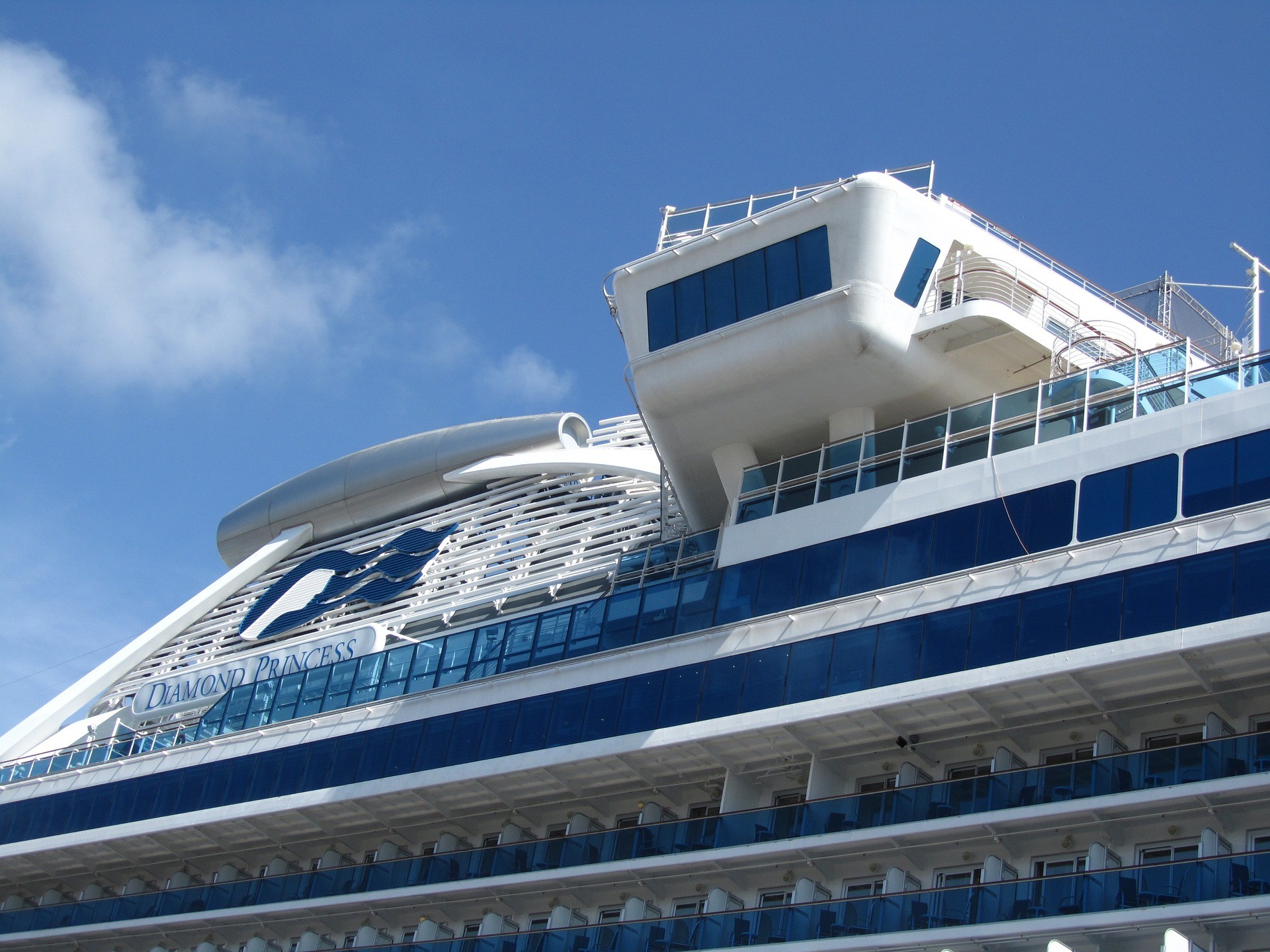
To the ultimate question, “how a cruise ship works,” let’s dive into how it works mechanically. What are the technical and mechanical aspects of a cruise ship? What does an engine do? How does a massive ship provide light, food, entertainment in the middle of an ocean? Is the water safe to drink?
Then, after reviewing how the cruise ship’s mechanics work, the answer to how a cruise ship works logistically can be answered. How do companies make a profit from these vast ships? How do the ships prepare for new passengers?
Technical Aspects of Cruise Ships
The technical aspects are a vital part of a cruise ship, so it will be first visited. Not to state the obvious, but the ship’s heart is shaped by the crew and the engineers that have put many hours and dedication into making a cruise ship work.
This is article will reveal the true hidden layers of what makes it all work starting from ground zero, the heart.
Technical Aspects
If you want one thing in a cruise ship aside from the cocktails and a nice tan, it’s the vessel’s stability and durability. Whether you are traveling through an unexpected storm or cruising on a gentle wave, your cruise ship should be the most stable in all situations.
How are cruise ships stabilized? The general idea for balancing and maintaining buoyancy is distributing the weight throughout the ship correctly, and of course, displacing the right about of water as it moves. So, let’s first talk about one of the most massive machinery onboard, the engine. Where does it sit and how does it run the cruise ship?
Engine Rooms
Where are the engines located? You guessed it, most heavyweights, such as engines, are found as low as possible in the lower decks, ground zero. For most cruise ships, the engines are close to the keel. The structural keel is the most closes to the bottom of the vessel and the ship’s wide hull. It runs the length of the vessel down its centerline and in most ships, you won’t have to go far to find the engine rooms.
Just because it’s placed low in the ship doesn’t mean it doesn’t take a lot of space. For all the ship’s power, the engine rooms can take up several decks high and are generally divided into several compartments. It may not feel like an open massive space, but it is truly the heart of the ship and the design of the rooms and placement are critical.
Usually, the primary concern for most ships is have engines and machinery compartmentalized for safety and avoiding fire hazards. Compartmentalized and labeled rooms make maintenance simpler and enhances safety for unprecedented accidents.
New legislations also support the requirement for compartmentalization. Ships are required to have at least a duplicate of equipment and at least two separate spaces for engines. So, what about these engines? Why are they so important and why do ships need so many of them?
Power and Engines
Just to answer those questions, we’ll have to visit more fundamental questions such as: How do the engines power a giant cruise ship? How does it help the ship propel forward? Are there specific engines that power different parts of the cruise? Out of many questions regarding the engines, the answer starts with the main engines.
The main engines are the engines that produce the majority of the power for the cruise ship to move. Depending on the type of vessel, the main engine connects to different parts of the propelling power. From traditional steamboats, to diesel electric, the engine is the fundamental powerhouse for the entire ship on the sea.
The following table is a general overview of how engines on different types of vessels are connected to the ship’s requirements.
So How Do These Engines Make the Ship Move?

As shown in the table, depending on the vessel type, the engine will provide power to different aspects of the ship. More or less, everything is distributed to operating proportions, but the key mechanics differ from one to another.
Diesel may be something more familiar to what we saw in old movies with steamboats. Even in modern days, we use similar mechanisms, if not labeled the same. The main difference is the source of pressure, which can be the traditional steam, or a fuel ignition.
Whether it is steam (traditional) or fuel ignition, the pressure generated from either push the pistons up and down in the vessel. These pistons connect to crankshafts through gears, which turns the pistons.
The crankshaft connects to the propeller through a long propeller shaft and gears, which further determines its speed in traditional diesel-powered vessels by steam pressure. Generally, the faster the pistons move up and down from the pressure, the quicker the propeller shifts would move.
With modern designs that control the propeller speed, engineers placed the gears in between the propeller and the engines which further enhances efficiency for both engines and propellers.
Again, although the majority of the engine provides electricity to the propeller shaft, electricity must be provided to the rest of the ship for entertainment. Often, options such as a shaft generator offer power to outlets such as lighting the dining and general appliances onboard while in motion.
Diesel-Electric
Diesel-electric is another form of vessels that are found commonly with conventional diesel vessels. Unlike the conventional diesel, diesel-electric engines are connected directly to the generators that provide the electricity for the propellers and main generators.
This electricity also provides direct power for the ship’s lights, appliances, and much more.
Environmentally Friendly Power
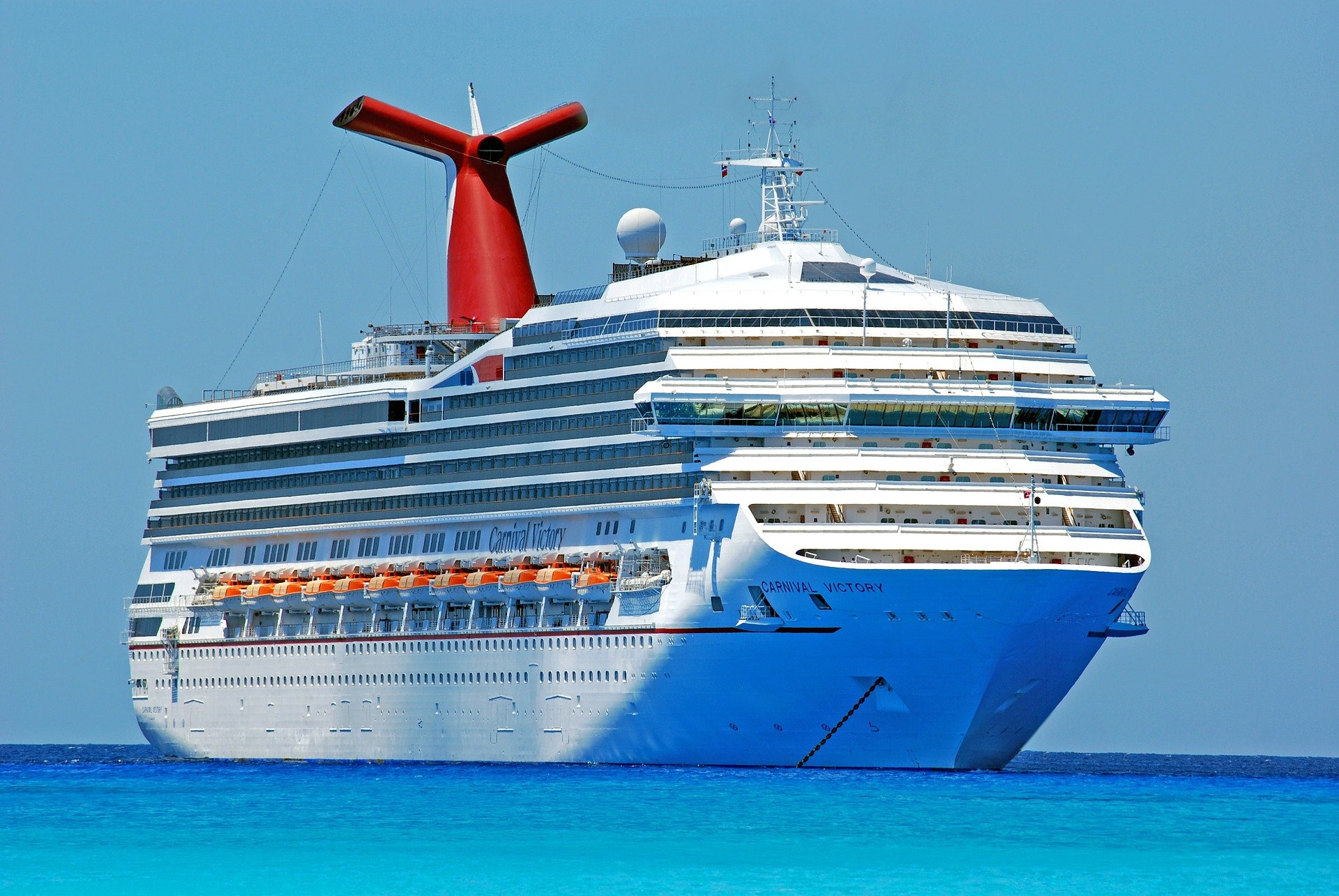
On a side note, if the thought of diesel in the ocean disturbs you, there is some good news! Thankfully, more and more environmentally friendly options are appearing for cruise ships. For example, liquified Natural Gas (LNG) is an alternative method for powering ships that burns natural gas for power.
Using natural gas could reduce nitrogen oxide and carbon dioxide emissions significantly! With green-oriented companies, more green cruises have been released in the past few years.
That being said, if you are looking to book a trip, be on the lookout for green cruising opportunities! Onboard, you can also find environmentally conscious crew members and less-waste policies.
Source: CruiseCritic , Windstar Cruises , Green Cruises
Fuel Consumption
So, how does fuel play a part in powering the engine and the cruise ship? Let’s go back and visit what an engine does. An engine generates electricity to the propellers by supplying power the propulsion motors. How do they get the electricity and what makes an engine work? Most likely fuel and ignition (besides the steamboat example from before).
How much Fuel?
In general, a large cruise ship can consume up to 250 tons of fuel a day, which is close to 80,000 gallons a day. For medium size cruise ships, consumption can still range up to 150 tons of fuel a day.
Onboard, a ship may carry up to 1 to 2 million gallons of fuel, depending on the vessel size. Most of the power, which can be close to 85%, goes to the propellers, while the rest goes to keeping the cruise lit and comfortable for the passengers and crew members.
While passengers dine and enjoy their cruise aboard, crew members are constantly maintaining the proper fuel levels and providing proper power for the ship. As for the captain of the ship, he also has several variables to keep in mind to control fuel consumption and safety.
Fuel consumption may vary for several reasons, just like when we are driving our cars (but with more variability). For example, depending on where the wind is hitting the ship, the fuel consumption can go 1 – 5% over the average consumption rate.
Here is a short list of variables that the captain is keeping track of:
- Speed of the cruise
- Sea conditions (vs. sailing direction)
- Weather (including the direction of the wind)
- Size of the ship
- Engine (Gas turbines, diesel-electric, diesel, or electric)
Source: Windstar Cruises , Cruise Mapper
Overall, the fuel, power, and engine, are all functions of making the magic happen. Starting from the design of the engine, to the crewmembers and captain maintaining the fuel and power consumption, a lot of action happens behind the scenes while passengers are onboard during vacation.
Floating and Buoyancy
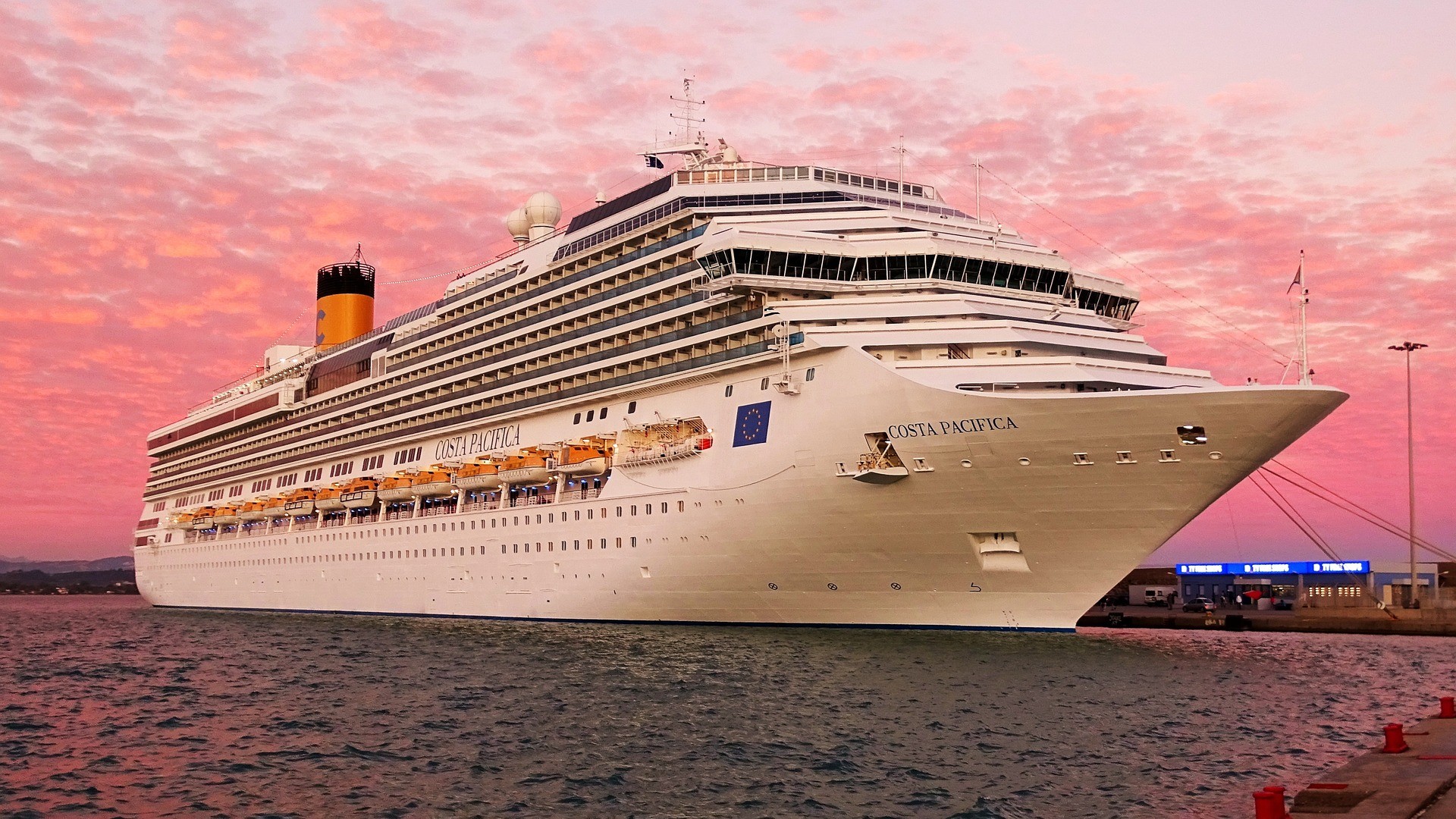
Now that the ship is powered, how do we ensure that it floats? How do these massive machineries, ice-skating rinks, restaurants, and bars float on water while keeping thousands of passengers safely onboard?
While the cruise ship constantly pushes the water out of its way when moving forward, the water being pushed will try to come back to its place. This displaced water pushes back with a force on the vessel which lets the cruise ship stay afloat.
This is the general idea when engineers designed the hull of the ship. This ratio has to be calculated when designing a ship and has to be correct. If you get a chance to see the hull of most ships, they have a wide U-shape hull at the front to maintain the displacement.
In addition to basic buoyancy principles, an engineer must also consider the ship’s average density. This means that the ship’s general open spaces must be considered on top of the vessel’s average weight, so the vessel remains “less dense” than the ocean’s (usually salty) water. A great example is a rock sinking vs. a beach ball floating on water.
Source: Express
Water Onboard
So the power, fuel, engine, and buoyancy are the fundamentals of the ship. What about the details of the cruise ship such as the water in your shower? Is it salty? Is it fresh? Where and how does that come to your room without running out.
In general, most cruise ships have a steam-evaporation system. Water is pumped and desalinated before going to your room. During this process, your water is distilled and desalinated using a reverse-osmosis system and filtration system.
Distillation and desalination process uses a purification system to take all contents out of the water. This is generally not healthy to drink, so this water is mineralized and chlorinated for taste and safety.
Additionally, some ships have water brought onboard for laundry and other maintenance purposes. Generally speaking, the water onboard available for drinking are tested and checked for purification. If you are ever in doubt, check with a crew member to ensure the water is safe for consumption.
Is the Water Safe?
The answer to your ultimate question is, no, the water you are drinking is not toilet water. Regulated by the Maritime Organization laws, all “toilet water” must be treated and discharged into the ocean at a specific distance from the land. This water is never treated and recycled for passengers to use again.
On a side note, if you feel uncomfortable drinking this water, bottled water will most likely be available onboard for purchase. If you need special water for medical needs, you will most likely be able to bring a few bottles on board by notifying them ahead of time.
Now that we have reviewed how cruise ships work mechanically, let’s dive into the ship’s logistics. How do they work? Who’s working, how is it supplied, and how are they so cheap? Or perhaps, why are they so expensive? All of these questions come down to logistics.
General Logistics
Depending on your opinion and type of cruise you may have signed up for, you may think that your cruise is way under or over-budget. The cruise companies measure these decisions and prices to minimize cost and maximize returns (of course).
For example, cruise ships avoid fines by taking specific lines. They must often save fuel and hiring a knowledgeable captain who can make these decisions and keep passengers aboard safe is essential.
So, what are the different divisions of a cruise vacation? Are some better than others?
Mainstream, Premium, and Luxury
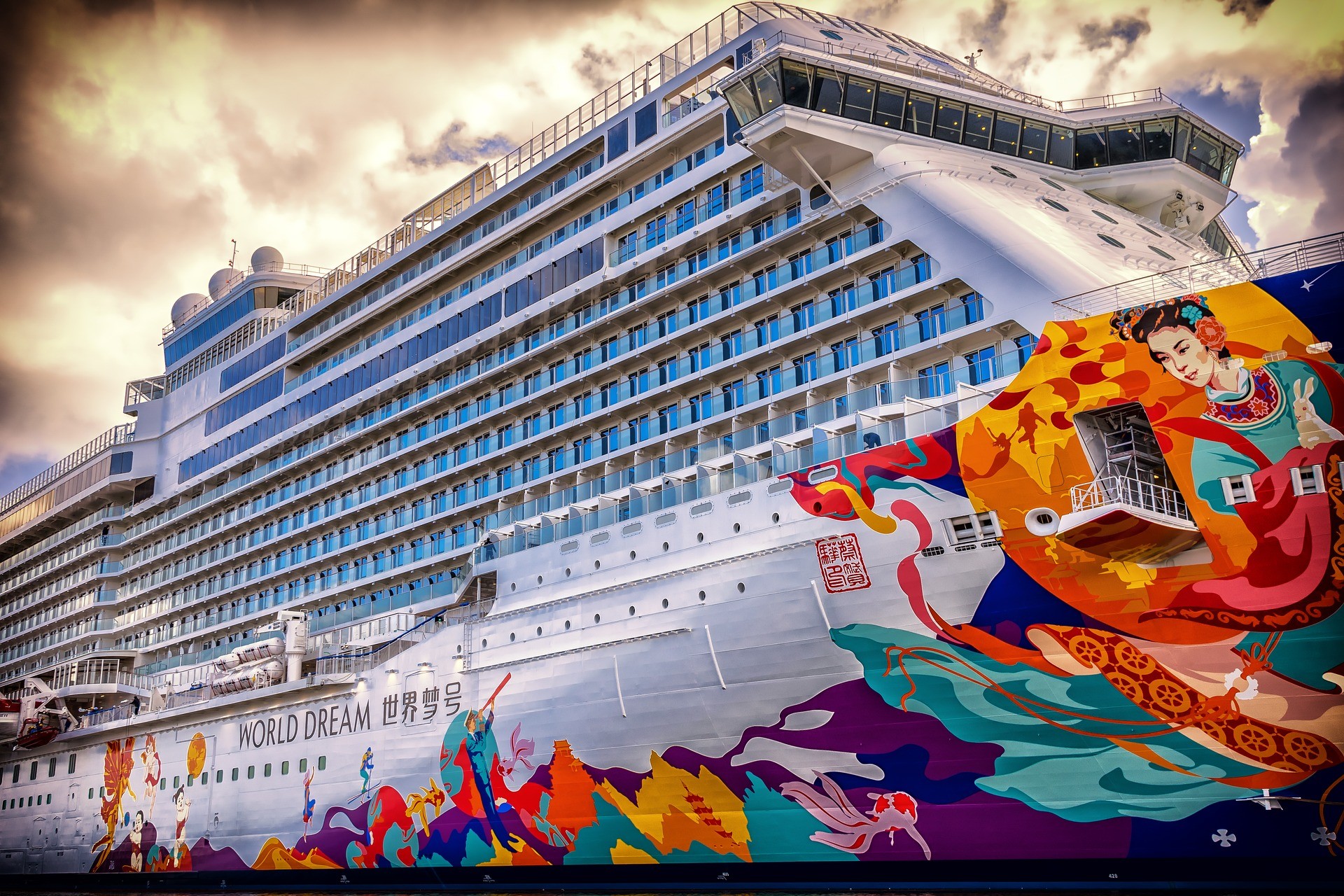
If we broke down cruises into 3 main categories, we could look at the mainstream, premium, and luxury lines of cruise types. You will often see categories within each of these types, but let’s break them down into the major categories for simplicity.
First, we will start with the mainstream cruise lines. These are cruises that are readily available, common, and well-known by the public with reasonable ticket costs.
Generally, these cruises’ primary business is through the onboard casinos, spas, shopping, and drinks. They suit the needs of most passengers. To make maximum profit, companies design these cruises by providing readily available entertainment on board. Most passengers are estimated to use 500$ onboard for their vacation experience.
Onboard, you will find general amenities, restaurants, bars, pubs, nightclubs, shopping, theaters, cinemas, swimming pools, gyms, karaokes, libraries, and even museums! These are great for big parties and are generally the biggest ships at sea.
Examples of Mainstream Cruise Lines that are known as “floating resorts”:
- Carnival Cruise Line
- Royal Caribbean International
- Norwegian Cruise line
- Lindblad Expeditions
- Amawaterways
Mainstream cruises are great for
- Group of friends
Source: NancyandShawnPower , Fodors , and Wind Rose Network
Premium lines are perfect for adults or those that are retiring. The brilliant catch is that many have policies of “no kids allowed,” making it an excellent selling point for adults who need some peace and quiet. These cruises make money upfront by offering more access to ports and offering the serene luxury.
Premium cruises generally have a refined style in comparison to mainstream cruise lines. Activities are more focused on lifestyles. For example, you may find computer classes or a language-learning class. Besides, these ships still offer resort-style pools, game nights, bingo, spas, gyms, and maybe even a jazz night.
The perks for a premium in comparison to the mainstream is the higher quality of cuisine. Usually offering specialty restaurants and quality chefs, the price may be higher, but the overall quality is higher. The rooms at premium cruise lines are also superior, often offering suites and rooms with balconies.
Examples of Premium Cruise Lines
- Princess Cruises
- Celebrity Cruises
- Holland America Line
The popular audience for Premium cruise lines:
- Older Adults
- Sometimes family-oriented
Source: Fodors
Luxury lines are pricier yet offer the best-selling point, fewer people onboard with a luxurious experience from beginning to end. The more expensive tickets provided to only a few hundred passengers make a profit for the company with the much higher ticket prices.
There are abundant space and a deluxe ship that will greet you as a valued guest from beginning to end for the high price. No doubt, one will fall for such an exquisite experience that starts from fine dining of caviar and foie gras to personal service available at one’s fingertips.
Course meals are offered from a full restaurant menu in your stateroom and served with limitless wine. Most interiors are luxurious and elegant, with rooms that are large and overlooking the sea.
Amenities range from gyms, spas, pools, and low-key entertainment. Generally targeting a niche group, most luxury cruise lines do not allow children.
Examples of luxury cruise lines:
- Windstar Cruises
- Paul Gauguin
- Silversea Cruises
- Crystal Cruises
- Oceania Cruises
Source: Cruise Critic
Many corporations own several of these different targets to make the most profit. Additionally, by corporations owning various cruise types, they can also hand down older ships throughout their other brands.
Logistics throughout the year

In addition to managing several types of cruises, there are numerous ways cruises have to operate to maintain their profits and not waste money through resting and selecting the wrong routes.
For example, cruise lines generally have high sales in November through April by Americans. The cold Americans usually take a warm vacation away from winter for a trip to the Caribbean.
What about other times of the year? Staying on seas without business is a considerable loss in revenue and usually unheard of. So, what do they do? They sell repositioning one-way tickets in April!
Generally, towards the end of April, you will start seeing two-week trips from the Caribbean to Europe. Typically, these trips can range from any state on the Eastern Coast of the United States to European countries.
Switching over/Cleaning
When there are one-way trips, there also needs to be exceptional coordination for a short turnaround between trips. When the cruise ships get to the destination, all hotels, theaters, dining, laundromat, and parks are cleaned and reset for the next people to come on board within half a day!
How do they do it?
During night-time, luggage and bags are ready ashore for passengers to check out. Meanwhile, all the trash is dumped, and the trash containments are cleaned, crew members switch, fuels are refilled, and food is refreshed with new inventory.
Remember the 1 to 2 million gallons of fuel to refill? This process, called bunkering, is a whole-team effort and is completed before the ship is ready to travel again.
A small boat, a “barge,” brings fuel to the 400 ports fueling for ships.
- Barge secures to the side of the cruise ship
- Connects a hose between the ship tanks
- Pumps fuel while watching guard
When passengers load off, then the cleaning crew comes to clean the rooms. While the ship is pampering, they complete paperwork from the first trip, fulfill any necessary maintenance, redecorate rooms, and start preparing and cooking food and lunch for the next set of passengers coming on board.
Soon, the ship is reloaded with happy passengers and starts to move again. They make their profits from when the Casinos start, and food is served.
Crew Members
This brings light to the less noticed crew members. The ones that make all the magic happen. Generally, a cruise will have 1 crew for 2 passengers. Most of the crew members are working very long hours for several months.
In general, these crew ships are in their rooms when not on duty and do not get in the passengers’ way. How do cruises afford these crew members and their extended hours of work? The trick is that cruises can register in any country to abide by their labor laws. This is how they keep costs low, but there is a catch to that.
Crews and Destination
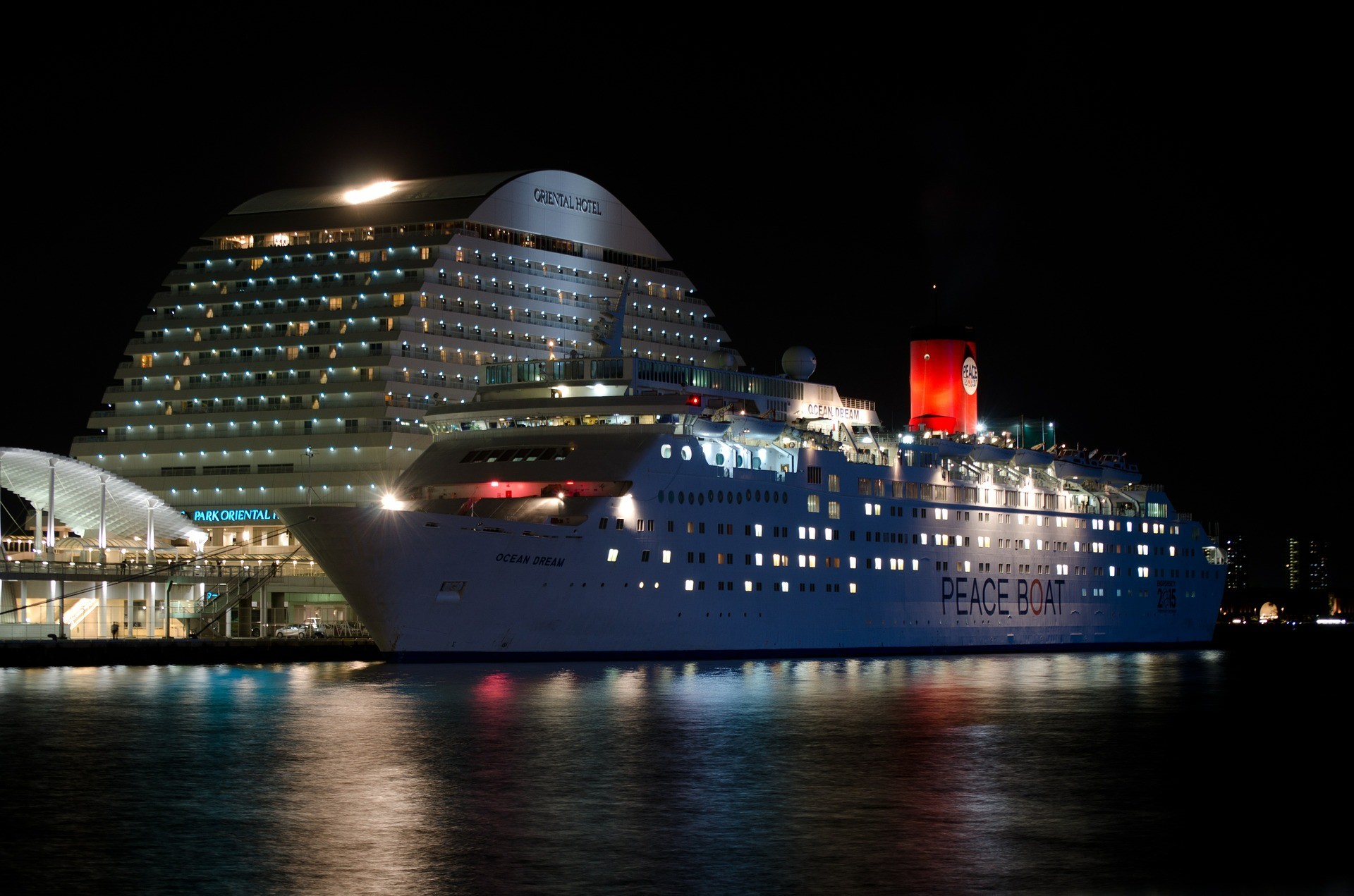
So, there is a catch, but it impacts your travel too. Did you ever wonder why cruises took less than expected stops? Not necessarily detours or emergency stops, but maybe a cruise led you to Ensenada or the Tabuaeran. This is due to the Passenger Vessel Services Act of 1886.
Why do cruises take weird detours?
Generally, a cruise ship can register any Labor law, as stated above. This makes it easy for cruise ships to pick a non-American country since it is cheaper and easier to fulfill (for business purposes). Unfortunately, if they choose this option, they must also abide by the Passenger Vessel Services Act of 1886. This act states that “No foreign vessel shall transport passengers between the United States.”
This means that if the cruise ship is registered under another country, they can never directly stop at an American stop if their initial take-off was in the United States. This is why you see stopes in Ensenada, for example.
For example, before Norwegian registered as American, if their cruise trip was to Hawaii from the motherland, they had to stop at Tabuaeran, a small island nearby.
When Norwegian registered as American, this let them bypass the Passenger Vessel Services Act. Unfortunately, this led the crew members’ service fees to rise, which led to higher ticket prices. If you want to watch how the above logistics work, check out this video !
A Cruise Ship Overview
Starting from the engine, fuel, and engineering to the logistics of companies, crewmembers, and governing policies, a cruise ship works in a marvelous way to shape every passengers’ experience abroad.
Thousands of crewmembers across various cruise ships, engineers of several centuries, and many hours of dedicated personnel make a cruise vacation work. Next time you are enjoying a cocktail on deck, remember that there is so much more behind the meaning of your cruise. There are so many parts that worked to make it happen! Enjoy and bon voyage!
Related Posts:

Submit a Comment Cancel reply
Your email address will not be published. Required fields are marked *
Save my name, email, and website in this browser for the next time I comment.

Privacy Overview
Optimized Cruise Liner Operation with Expert System Simulation and Condition Monitoring
- Cover Story
- Systems Engineering
- Published: 16 March 2018
- Volume 8 , pages 26–33, ( 2018 )
Cite this article

- Hinrich Mohr 1 ,
- Martin Abart 1 ,
- Vasilios Lamaris 1 &
- Robert Strasser 1
89 Accesses
Explore all metrics
This is a preview of subscription content, log in via an institution to check access.

Access this article
Price includes VAT (Russian Federation)
Instant access to the full article PDF.
Rent this article via DeepDyve
Institutional subscriptions

http://www.cruisemarketwatch.com/growth/
2017 Cruise Industry Outlook by CLIA. https://www.cruising.org
Sala, S.: Energy Efficient Design and Operation of Cruise Vessels. 6 th International Conference Ship Efficiency, Hamburg, September 2017
Google Scholar
Abart, M.; Lamaris, V.; Eder, S.; Teichmann, R.; Mohr, H.; Takanabe, M.; Taya, C.: Benefits of Cylinder Pressure Based Engine Condition Monitoring using Expert Algorithms — Analysis based on 10 years of experiences in the field. International Symposium on Marine Engineering (ISME), Tokyo, October 2017
Mohr, H.; Zabeu, C.; Abart, M.; Koops, I.; Teichmann, R.; Martelli, A.; Salvador, R.; Peñaranda, A.; Ruy, G.: Operational Optimization of Gas Engine Power Plant by integrated Approach of Expert Condition Monitoring and Closed-Loop Engine Control. 10 th Dessau Gas Engine Conference, Dessau, April 2017
Mohr, H.: World's first Dual-Fuel Conversion of High-Performance Diesel Engines for Fred. Olsen Express High-Speed Crafts. European Marine Engineering Conference 2017, Amsterdam, April 2017
Schyr, C.: Modular Test Environment for Autonomous Navigation Systems; Maritime & Naval Test & Development Symposium 2017, Amsterdam, June 2017
Download references
The authors greatly thank Karl-Heinz Fölzer and Dr. Rüdiger Teichmann, both AVL List GmbH, for their support and contribution to this paper.
Author information
Authors and affiliations.
AVL List GmbH, Graz, Austria
Hinrich Mohr ( Key Account Manager and Product Manager System Integration Large Engines ), Martin Abart ( Product Manager Condition Monitoring Systems ), Vasilios Lamaris ( Technical Expert Engine Diagnostic and Field Support ) & Robert Strasser ( Lead Engineer System Simulation )
You can also search for this author in PubMed Google Scholar
Rights and permissions
Reprints and permissions
About this article
Mohr, H., Abart, M., Lamaris, V. et al. Optimized Cruise Liner Operation with Expert System Simulation and Condition Monitoring. MTZ ind 8 , 26–33 (2018). https://doi.org/10.1007/s40353-018-0001-1
Download citation
Published : 16 March 2018
Issue Date : March 2018
DOI : https://doi.org/10.1007/s40353-018-0001-1
Share this article
Anyone you share the following link with will be able to read this content:
Sorry, a shareable link is not currently available for this article.
Provided by the Springer Nature SharedIt content-sharing initiative
- Cruise Lines
- Condition Based Maintenance (CBM)
- Maximum Cylinder Pressure
- Cylinder Balancing
- Find a journal
- Publish with us
- Track your research

How Ship’s Engine Works?
Marine engines on ships are responsible for propulsion of the vessel from one port to another. Whether it’s of a small ship plying in the coastal areas or of a massive one voyaging international waters, a marine engine of either 4-stroke or 2-stroke is fitted onboard ship for the propulsion purpose.
The marine engines are heat engines used for converting heat, which is generated by burning fuel, into useful work, i.e. developing thermal energy and transforming it into mechanical energy. The engines used onboard ships are internal combustion engines (a type), in which, the combustion of fuel takes place inside the engine cylinder and the heat is generated post the combustion process.
Ship Engine Working Principle
As mentioned earlier, IC (Internal combustion) engines are mainly used for marine propulsion and power generation purpose. The working of the marine engine can be explained by the following procedure:
– The fuel is injected at a controlled amount at high pressure
– A mixture of fuel and air is compressed inside the engine cylinder with the help of piston, which results in the explosion of the mixture when pressurized due to compression. As a result, heat is released which increases the pressure of the burning gas

– The sudden increase in the pressure pushes the piston downwards and transmits the transverse motion into the rotary motion of the crankshaft using connecting rod arrangement. The explosion is repeated continuously for maintaining the power output depending upon the type of marine engine and its usage.
Related Read: 14 Terminologies Used for Power of the Ship’s Marine Propulsion Engine
The crankshaft is connected via a flywheel, either to the alternator or to a propeller arrangement for doing the mechanical work. To obtain continuous rotation of the crankshaft the explosion has to be repeated continuously.
Before the next explosion, the used gases are drawn out from the cylinder through an exhaust valve and fresh air is supplied, which helps to push the used gas and also to provide fresh air for next combustion process.
Related Read: Components and Design of Exhaust Gas System
Types of marine diesel engines:
The two basic types of marine diesel engines are –
- 4 stroke engine
- 2 stroke engine
A 4 stroke engine can be installed on the ship to produce electrical power and also to propel the ship (usually in small size vessel). This engine takes 4 cycles to complete the transfer of power from the combustion chamber to the crankshaft.
Related Read: Why 2-stroke Engines are Used More commonly for propulsion than 4-stroke on Ships?
The events taking place in I.C. engine are as follows:
- Suction stroke for taking the fresh air inside the chamber – which is the downward movement of the piston
- Compression stroke to compress the air-fuel mixture – which is an upward movement of the piston
- Power stroke – in which the explosion takes place and the piston is pushed downwards
- Exhaust stroke – which is an upward movement of the piston to draw out used gases
The four events are completed in four strokes of the piston (two revolutions of the crankshaft). An inlet and exhaust valve is fitted on top of the cylinder head to draw in fresh air and to expel the used exhaust gas.

Both, the valves and the fuel pump (which supply fuel to the injector), are operated using camshaft, which is driven by crankshaft using a gear drive. In a four-stroke engine, the camshaft runs at half the speed of the crankshaft. The crankcase is open to the piston liner arrangement, which assists in the lubrication of the liner.
The 2 stroke engines are used for vessel propulsion and are bigger in size as compared to the 4 stroke engines. In this engine, the complete sequence is complete in two cycles i.e.
- Suction and compression stroke – which is the upward movement of the piston to draw fresh air inside and to compress the air-fuel mixture
- Power and exhaust – which is the downward movement of the piston due to an explosion inside the chamber followed by removal of exhaust through the exhaust valve fitted on the top of the cylinder. A stuffing box is used which separates and seals the crankcase against the combustion chamber.
A basic ship engine working video is shown below:
This video shows how a 2 stroke marine engine on ship works-
How and where is ship’s engine made?
If you have seen engines on ships, including small 4 stroke generator engines and also the massive 2 stroke propulsion engines, one thought which must have crossed your mind is how and where these engines were made?
The most famous engine manufacturers, whose engines, are used in ships are:
- MAN Diesel & Turbo (Previously B&W engines) – famous for high, medium and slow speed marine engines
- Wartsila (Previously Sulzer Engines) – famous for high, medium and slow speed marine engines
- Mitsubishi – producing engines for light, medium, and heavy-duty applications
- Rolls Royce – famous for the cruise ship and naval ship engines
- Caterpillar manufactures – for medium speed and high-speed marine diesel engines
Related Read: The Most Popular Marine Propulsion Engines in the Shipping Industry
Wartsila is still the Guinness World Record holder for the largest ship engine ever built.
The Wärtsilä RT-flex96C two-stroke engine fitted with turbocharger holds this record. Manufactured for large container ships , its dimensions are as follows:
Length – 27 metres (88 ft 7 in),
Height- 13.5 metres (44 ft 4 in)
weight > 2,300 tonnes.
Power output~ 84.42 Megawatts (114,800 bhp).
The size of the ship engine varies from ship to ship, type of stroke it has, and its power output. The ship engine can be as high as a 5 story building, and to accommodate it, the ship engine room has to be designed accordingly.
Where are marine engines made?
These marine engines are built at the facilities of the manufacturers. For e.g. MAN Diesel has production facilities in Augsburg, Copenhagen, Frederikshavn, Saint-Nazaire, Shanghai, etc.
Similarly, Wartsila has facilities in Finland, Germany, China etc.
The ship’s engine can also be made in reputed shipyard if there is a contract between the two companies.
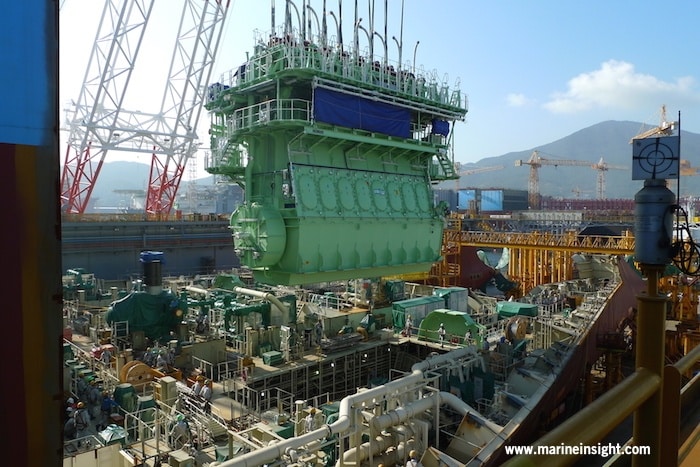
The engine is usually made in three different sections (explained below) and depending upon the size of the engine room and access for the installation, it can be fitted in the shipyard either in sections or as an entire assembly.
Related Read: How Massive Main Engines are Fitted in the Ship’s Engine Room?
Material Used For Making Ship Engine
The material used for making the ship’s engine and different ship engine parts are:
Bedplate: The bedplate is the bottom-most portion of the engine which is the base of the engine and accommodates crankshaft bearings and A-frame. For the small engine, a single casting of cast iron is used and for large 2 stroke engines, fabricated cast steel transverse sections with longitudinal girders are used.
Related Read: Important Things To Check In Ship’s Engine Bedplate
A frame: The A-frame, as the name suggests, is similar to the shape of letter ‘A’ and is installed above the bedplate of the engine. It is built separately to carry the crosshead guide and on top, it supports the base of the entablature. The bottom surface of the A-frame is machined for making a mating surface to install on top of the bedplate.
Entablature: The entablature , also known as cylinder block, is made from cast iron and used to accommodate the cooling water and scavenge airspace. Depending upon the size of the engine, the casting can be either for individual or multicylinder (bolted together). The lower portion of the cylinder block is machined to form a mating surface and fastened with the A-frame using fitted bolts.
The other different ship engine parts which are fitted inside the engine are:
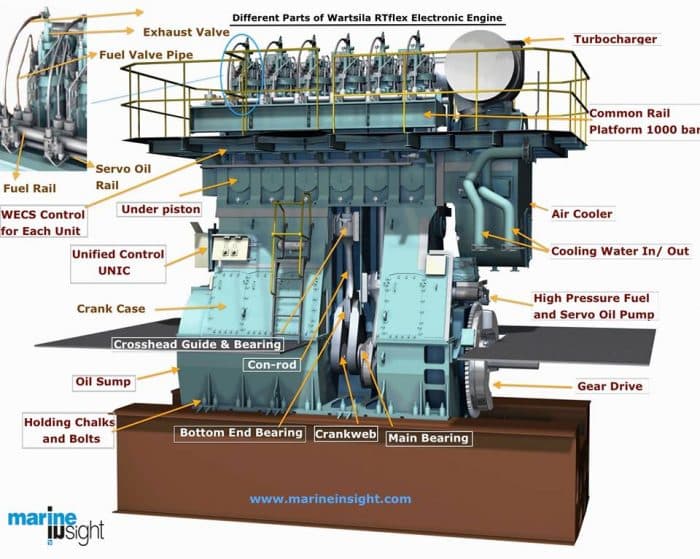
Piston, liner, cylinder, connecting rod, crankshaft, camshaft, fuel pump, exhaust valve, etc. and these important parts can be studied in details in our ebook –
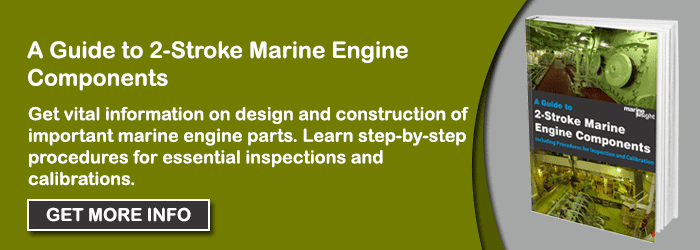
Ship engine maintenance
The basic ship engine maintenance comprises of planned maintenance which includes overhauling of important moving and static parts of the combustion chamber.
Following are some of the most common maintenance done on the marine engine:
- Overhauling and measurement of Piston, rings and piston rod
- Overhauling and measurement of the cylinder liner
- Overhauling and measurement of the exhaust valve
- Overhauling and measurement of the stuffing box
- Overhauling and measurement connecting rod and crosshead bearings
- Overhauling and measurement of main bearings
Related Read: Types of Main Bearings of Marine Engines and their Properties
7. Measurement of crankshaft deflection
8. Checks and measurement of fuel pump timing
9. Checks and overhauling of starting air system
The time between overhauling of different parts of the engine is provided by the manufacturer in the engine manual. The maintenance needs to be performed as per the time specified between two overhauling durations, irrespective of issues shown by the engine.
Apart from timely overhauling, the engine ratings and power needs to be checked using digital power indicator. The scavenge space inspection is also done to check the condition of the piston ring, which in turn defines the efficiency of the lubrication system of the cylinder liner.
Marine engines used on ships are some of the most sophisticated and complicated engineering works. Marine engineers are therefore provided special training for operating, maintaining and troubleshooting marine engines on board ships.
You may also like to read:
Things to Consider During Fuel Valve Overhauling
Do you have info to share with us ? Suggest a correction

About Author
Raunek Kantharia is a marine engineer turned maritime writer and entrepreneur. After a brief stint at the sea, he founded Marine Insight in 2010. Apart from managing Marine Insight, he also writes for a number of maritime magazines and websites.
Daily Maritime News, Straight To Your Inbox
Sign Up To Get Daily Newsletters
Join over 60k+ people who read our daily newsletters
By subscribing, you agree to our Privacy Policy and may receive occasional deal communications; you can unsubscribe anytime.
Leave a Reply
Your email address will not be published. Required fields are marked *
Subscribe to Marine Insight Daily Newsletter
" * " indicates required fields
Marine Engineering
Marine Engine Air Compressor Marine Boiler Oily Water Separator Marine Electrical Ship Generator Ship Stabilizer
Nautical Science
Mooring Bridge Watchkeeping Ship Manoeuvring Nautical Charts Anchoring Nautical Equipment Shipboard Guidelines
Explore
Free Maritime eBooks Premium Maritime eBooks Marine Safety Financial Planning Marine Careers Maritime Law Ship Dry Dock
Shipping News Maritime Reports Videos Maritime Piracy Offshore Safety Of Life At Sea (SOLAS) MARPOL
WAIT! Did You Download 13 FREE Maritime eBooks?
Sign-up and download instantly!
We respect your privacy and take protecting it very seriously. No spam!
WAIT! Did You Download 12 FREE Maritime eBooks?
- The Inventory
The Largest Piston Engine In The World Makes People Look Shrink-Ray'd
Anyone thinking about swapping a container ship engine into your '86 Celica? Better think again — these things are huge . You'd probably need something with more room, like a Toronado, or if you're thinking of the 25,480L, 14 cylinder Wärtsilä RTA96-C , maybe something even bigger. Like a vacant lot.
Related Content
The RTA96-C (or the newer RTAflex96-C) is a two-stroke, turbocharged diesel engine designed to run at very low speeds. When each cylinder is 1820 liters, you don't really need all that much speed. In fact, the engine runs at a fairly lethargic 22- 102 RPM, though even at those low speeds you're getting 5,608,310 lb-ft of torque and up to 108,920 BHP. Holy crap. That's the sort of power that God's dad's boss's Ultra-Camaro makes.
But the best thing about the RTA96-C engine is the sheer, improbable scale of it, and how it still, fundamentally, looks like the sort of engine's we're all familiar with. That means in photos of people next to the engine or engine parts, our brains want to read these people as victims of a shrink-ray. These pictures always make me do a double-take.
Also remarkable is that this engine gets mentioned in meme-ified screenshots from the Fast and Furious movies:
Now let's all sit back and bask in just how big this thing is. Look at this picture of a bent rod from one of these. Now just contemplate the forces involved with that.
Holy crap, right?
Which cruise brand is best for you? A guide to the most popular lines

Thinking about booking your first cruise? The sheer range of choices can be daunting. There are more than two dozen lines marketing to North Americans — no two alike.
The list of brands includes everything from giant companies such as Royal Caribbean and Carnival Cruise Line, which are household names, to lesser-known small operators such as Windstar Cruises.
Some of the brands — Royal Caribbean, MSC Cruises and Norwegian Cruise Line, in particular — operate massive vessels that are like giant floating resorts with deck-top water parks and other over-the-top amusements . Others specialize in intimate, boutique hotel-style ships.
For more cruise guides, news and tips, sign up for TPG's cruise newsletter.
Some lines, such as Carnival, are aimed at a budget crowd. Others operate vessels that are as luxurious as any upscale resort found on land. A few small luxury players such as Regent Seven Seas Cruises have ships with lavish suites that'll cost you as much as $11,000 a day .
Where should you start your search for the perfect cruise for you? Below, you'll find our quick guide to some of the most popular cruise brands. As you'll see, it's not meant to be an in-depth review of the lines. It's just a short overview — enough to give you a sense of which particular cruise operator might best appeal to you.
Once you've narrowed down the choices to a few brands that you think best fit your style, do a deeper dive into them and their specific ships, their itineraries and home ports and their comparable costs (either on your own or with the help of a cruise-savvy travel agent ). Note that TPG has many guides to individual lines, which you can find by clicking on our cruise line hub pages linked in each segment below.
Related: TPG's ultimate guide to picking a cruise line
With just four ships, each holding fewer than 700 passengers, Azamara is one of the smallest players in the cruise business. But it has a loyal following of travelers who appreciate the upscale ambience of its vessels, the inclusive amenities it offers (including gratuities and alcoholic drinks) and its destination focus.
The line prides itself on offering longer stays in ports, including multi-day visits. Its ships have an intimate, boutique-hotel feel. Pricing is higher than at the big, mass-market lines but not quite as high as you'll find at luxury lines.
Related: 5 things to love about Azamara's newest ship
Carnival Cruise Line
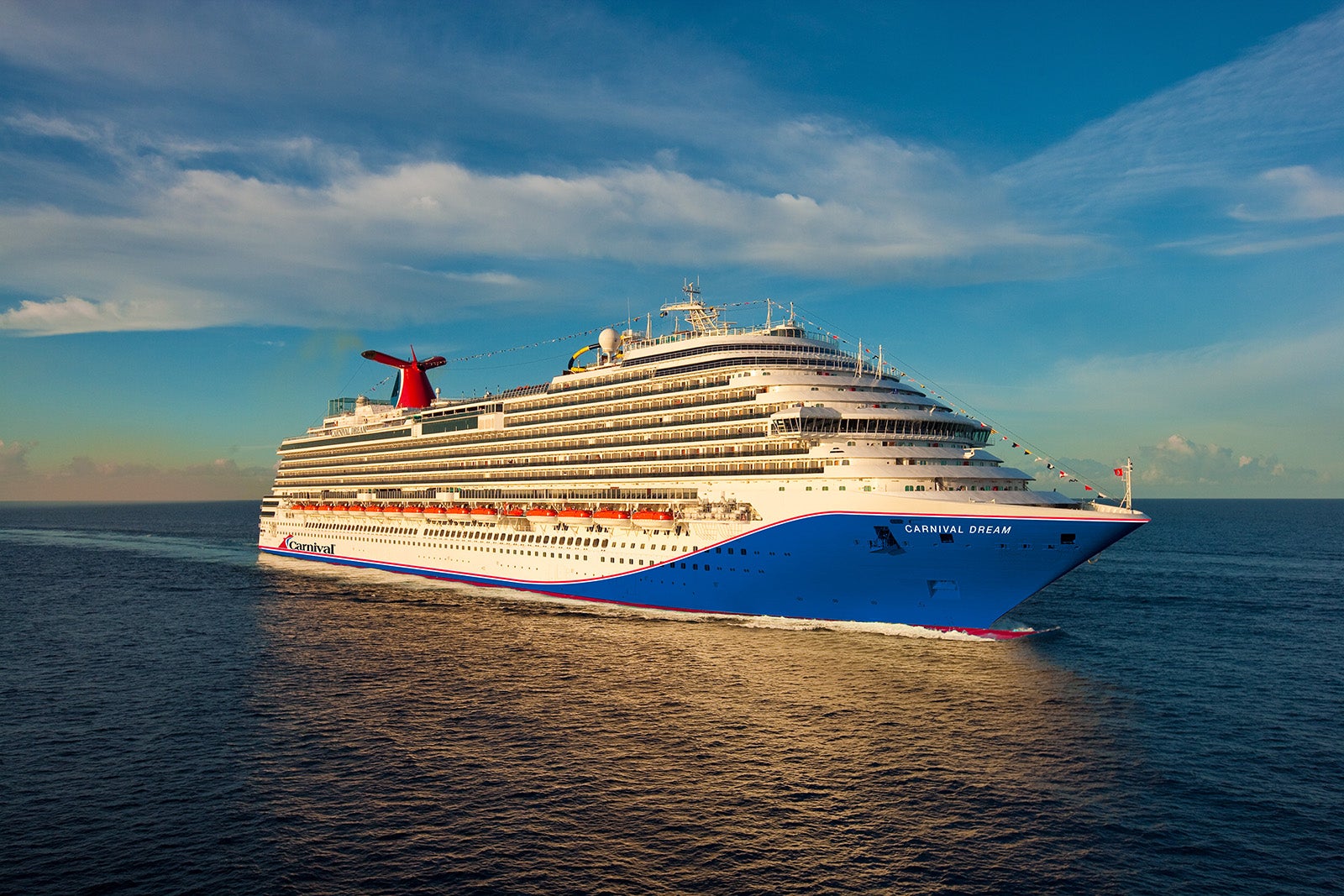
The self-described "fun ship" line is the king of short, affordable, fun-focused cruises from U.S. ports to the Caribbean, the Bahamas, Mexico and beyond.
The choice of roughly one in five cruisers, Carnival Cruise Line' s ships are notoriously lively, flashy and packed with fun features such as water parks with multiple waterslides. Just don't expect anything too fancy .
Related: The ultimate guide to Carnival Cruise Line
Celebrity Cruises
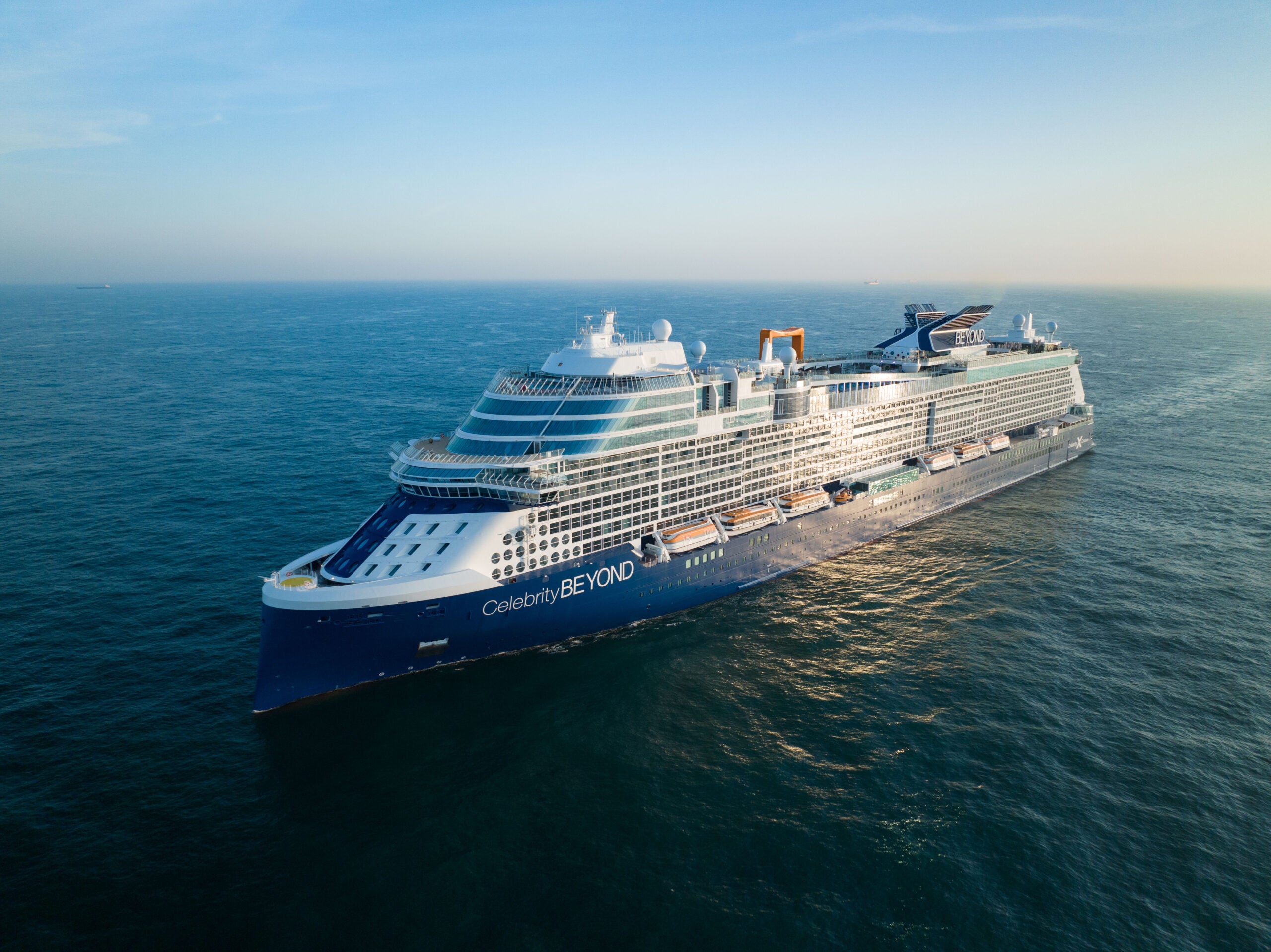
Designed to be a cut above mainstream options such as Carnival while remaining relatively affordable, this Miami-based "premium" line is known for some of the most stylish big ships at sea.
Expect high-end design, cutting-edge art and trendy restaurants. In short, Celebrity aims for sophisticates, not the party crowd (although it's not a luxury product).
Celebrity's four newest ships, Celebrity Edge , Celebrity Apex , Celebrity Beyond and Celebrity Ascent, feature "infinite veranda" cabins that are open to the sea in a way we haven't seen with other ocean ships. They boast a glass wall that opens from the top to create a balcony-like effect.
Crystal Cruises
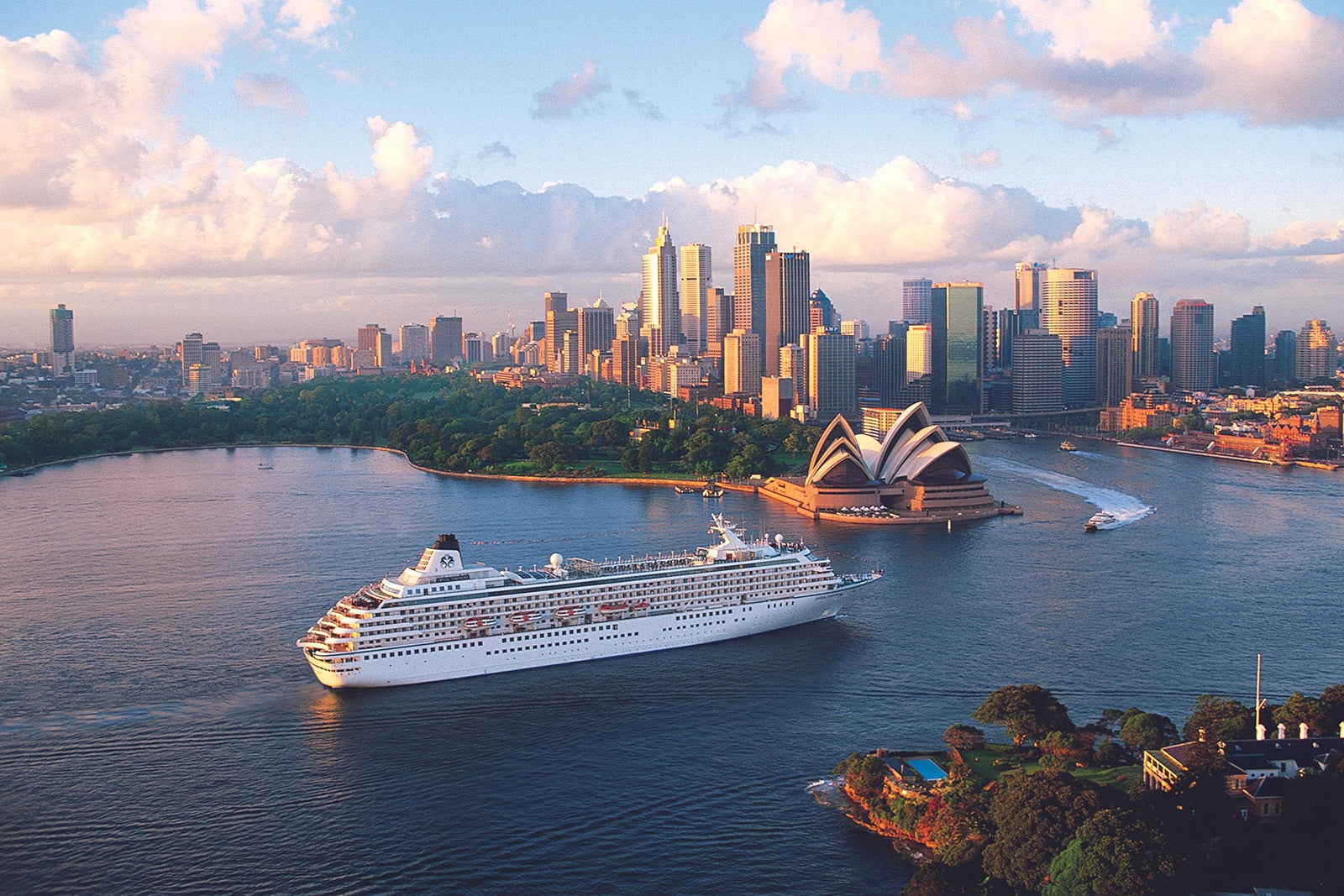
This much-beloved luxury line recently restarted operations under new owners after shutting down for 18 months. For years, it was considered the ultimate luxury cruise operator, and our take after sailing on Crystal Serenity after its relaunch is that the line is even better than before. Initially, Crystal has returned to operations with just two ships. But it recently announced plans to expand rapidly with four more ships over the next six years.
A storied line with roots that go back to the 1800s, this three-ship brand is perhaps best known for its 2,695-passenger flagship, Queen Mary 2. The ship lives up to its billing as a true ocean liner with semiregular, transatlantic service between Southampton, England, and New York.
Cunard fans love the line's relatively formal vibe (including nightly dress codes) and other nods to ocean liner tradition, including evenings with ballroom dancing. A fourth Cunard ship called Queen Anne is set to debut in 2024.
Related: Why I was wrong about transatlantic cruises
Disney Cruise Line
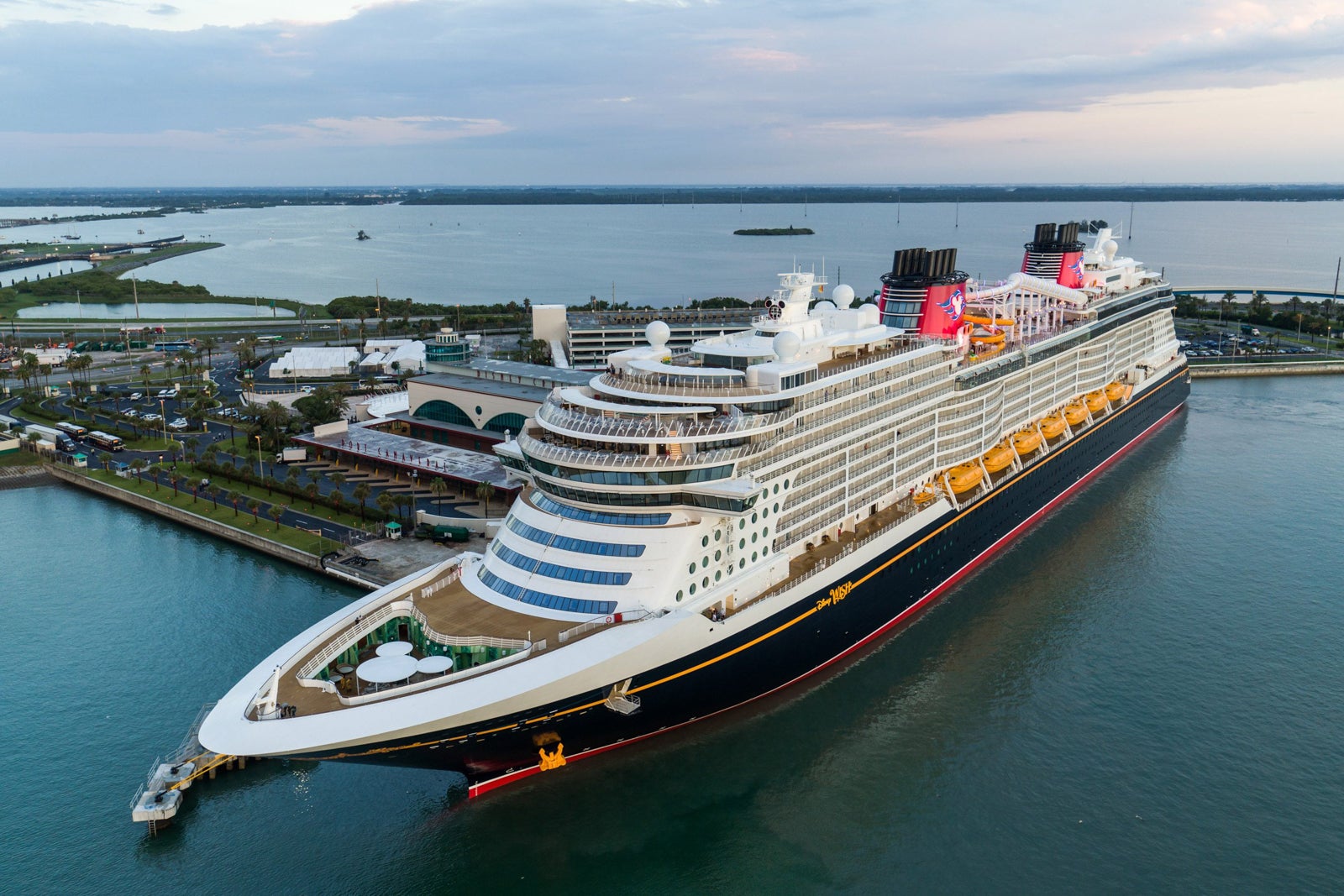
Meet-and-greets with Disney characters, Disney-themed shows and the most extensive kiddie fun zones on the high seas are just a few of the family-friendly allures of a Disney cruise . If you're a Disney fan, nothing quite compares.
If Disney isn't your thing, well, this probably isn't the line for you. The biggest downside of the brand? As with Disney's parks on land, it doesn't come cheap.
Related: A first-look photo tour of Disney's newest ship, Disney Wish
Holland America
Tradition long has been a touchstone for this storied line, which dates to 1873 and is known for carefully crafted, globe-circling itineraries on midsize ships.
However, Holland America has been shaking things up in recent years with lively new venues such as B.B. King's Blues Club. Couples and retirees are the market for this line. Families with kids might want to look elsewhere.
MSC Cruises
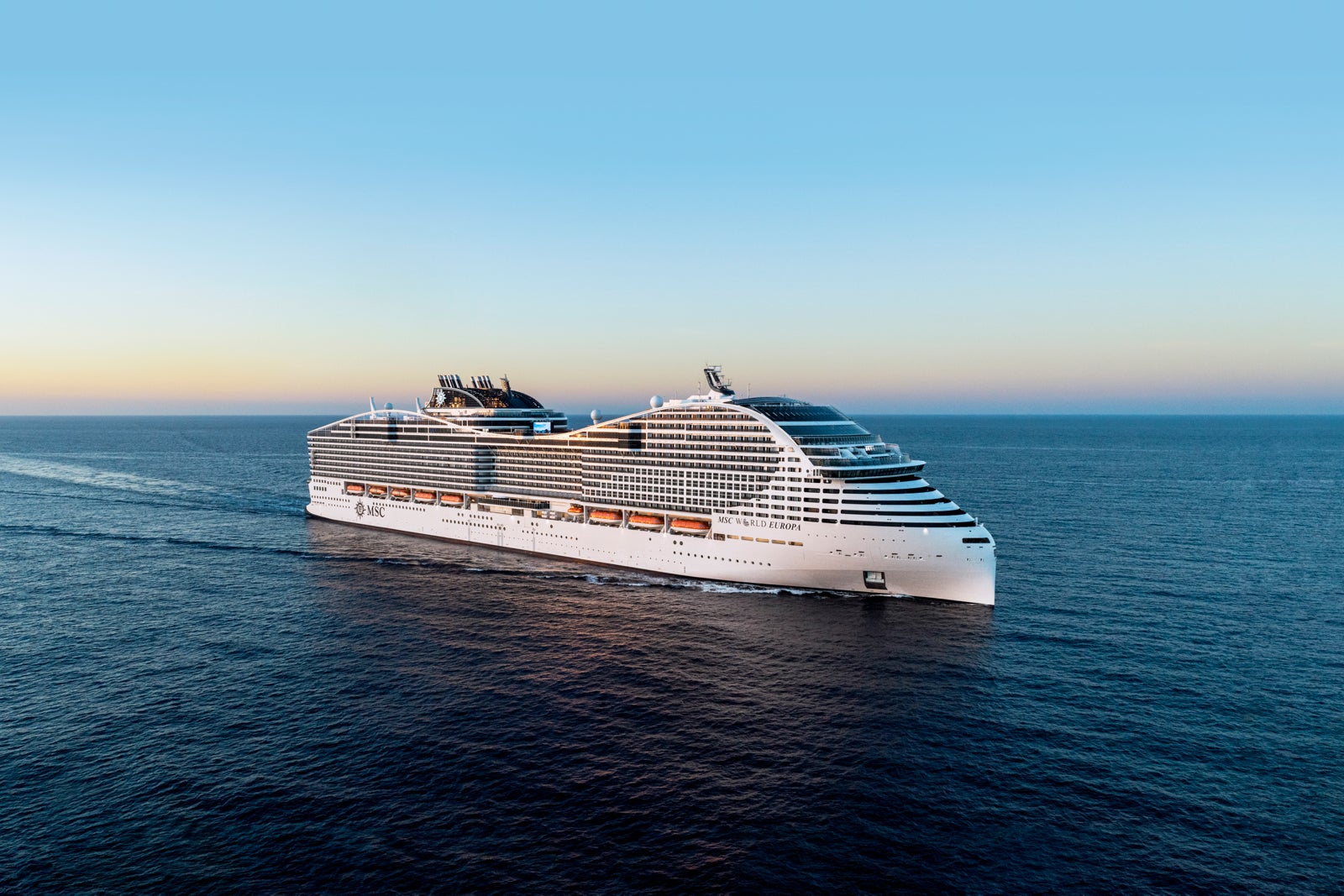
A giant of cruising in Europe, Switzerland-based MSC Cruises is making a big play for North Americans with newer, bigger ships sailing year-round from Florida to the Caribbean and Bahamas. It also offers sailings from New York City.
Like Royal Caribbean and Norwegian, MSC Cruises operates big, resort-like vessels that appeal to a broad audience. Among the highlight of its cruises in North America are stops at its new private island in the Bahamas, the Ocean Cay MSC Marine Reserve .
Norwegian Cruise Line
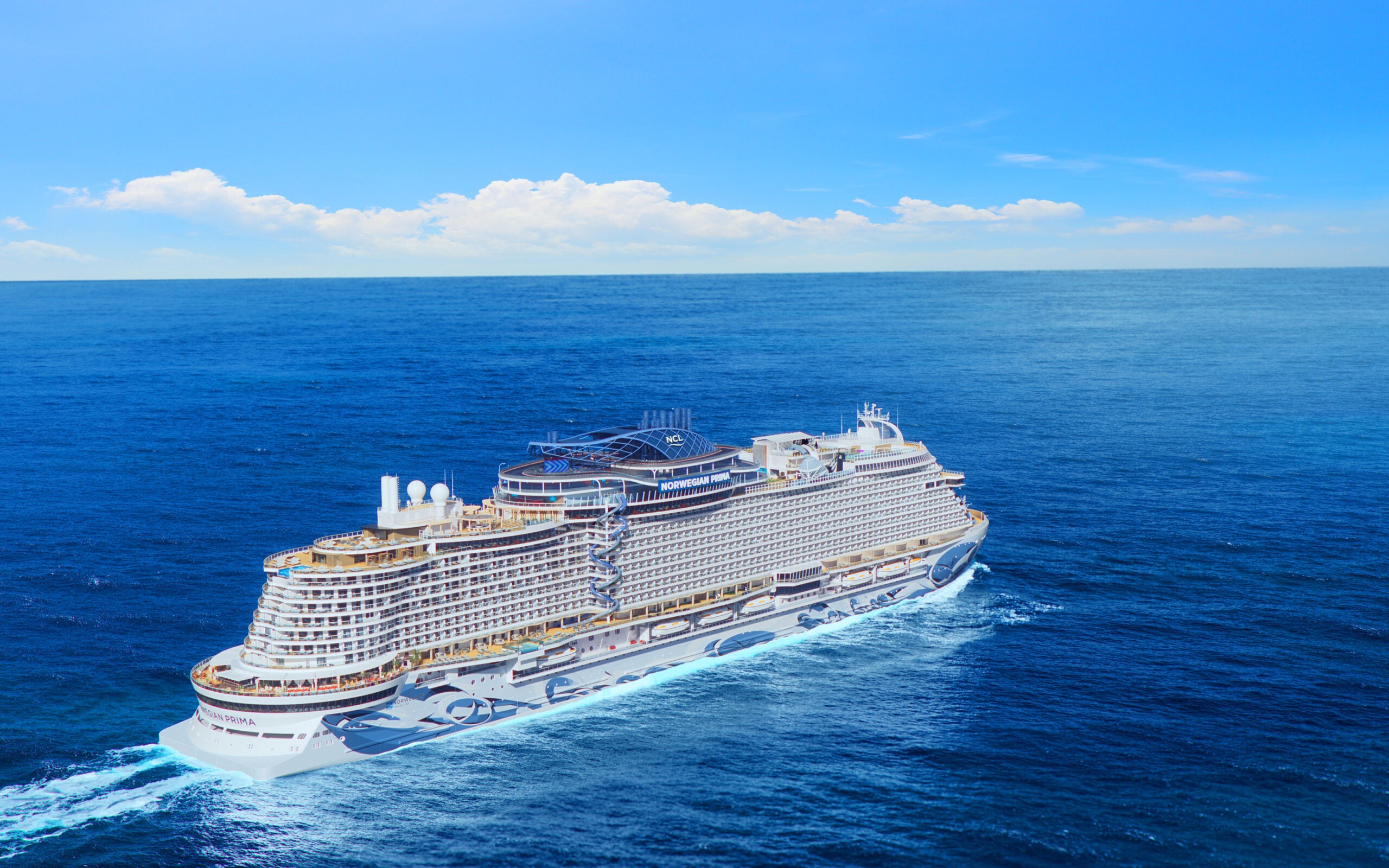
Multistory waterslides, ropes courses and even go-kart race tracks are among the gee-whiz attractions atop Norwegian Cruise Line 's giant, resort-like ships. The vessels also are packed with eateries, bars, casinos and showrooms.
The brand is known for its entertainment, including big Broadway shows such as "Beetlejuice." If you're looking for a Las Vegas-style resort at sea, this is your line.
Oceania Cruises
Oceania has carved out a niche with relatively small, upscale ships that offer a significant upgrade from mass-market vessels but aren't quite as fancy (or pricey) as luxury offerings.
Its seven ships feature a relaxed, country club-like ambience and inspired dining that appeal to a mostly older crowd.
Itinerary-wise, Oceania is known for destination-intensive voyages that typically are 10 nights or more in length, with some globe-circling trips as long as 180 days.
Related: Take a look at Vista, Oceania's stunning new ship
This France-based line is a specialist in expedition cruising , a type of cruising that involves traveling to remote, hard-to-reach places on small, hardy vessels that carry their own landing craft.
Operating a fast-growing fleet of tough but upscale expedition ships (none carrying more than 264 passengers), Ponant is known for voyages to places like Antarctica and the Arctic.
If you're looking for waterslides and laser tag, this is not the cruise line for you.
Related: This epic Ponant trip will take you to the North Pole
Princess Cruises
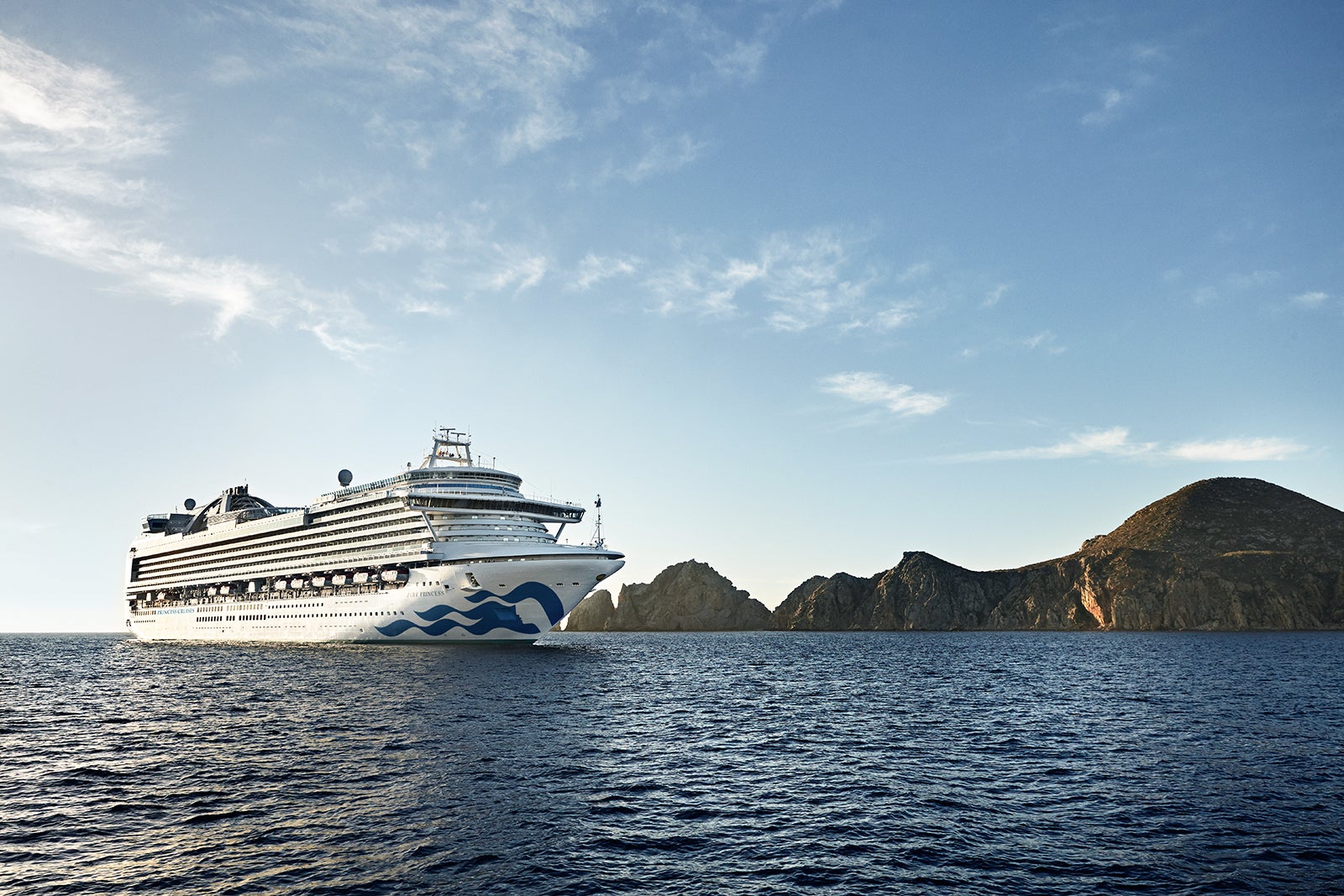
Popular with middle-aged couples, retirees and multigenerational families, the "Love Boat" line's ships aren't as flashy (or big, for the most part) as those of Royal Caribbean and Norwegian, and that's just the way its customers like it.
Princess Cruises ' customers also like its wide range of itineraries, including voyages in Asia and Australia, as well as closer-to-home places like the Caribbean. It's long been one of the dominant lines in the Alaska cruise market.
Related: The ultimate guide to Princess Cruises
Regent Seven Seas Cruises
This Miami-based luxury line operates some of the most opulent vessels at sea, including three recently unveiled Explorer-class ships billed as the most expensive luxury vessels ever built on a cost-per-berth basis.
Regent Seven Seas Cruises is particularly known for some of the most over-the-top suites at sea (including some bigger than the average American home ), some of the most inclusive fares in the cruise business and high levels of service. The only catch: You'll pay a pretty penny for it. Rooms on Regent ships start at around $1,000 per person per day and can cost as much as $5,500 per person per day.
Royal Caribbean
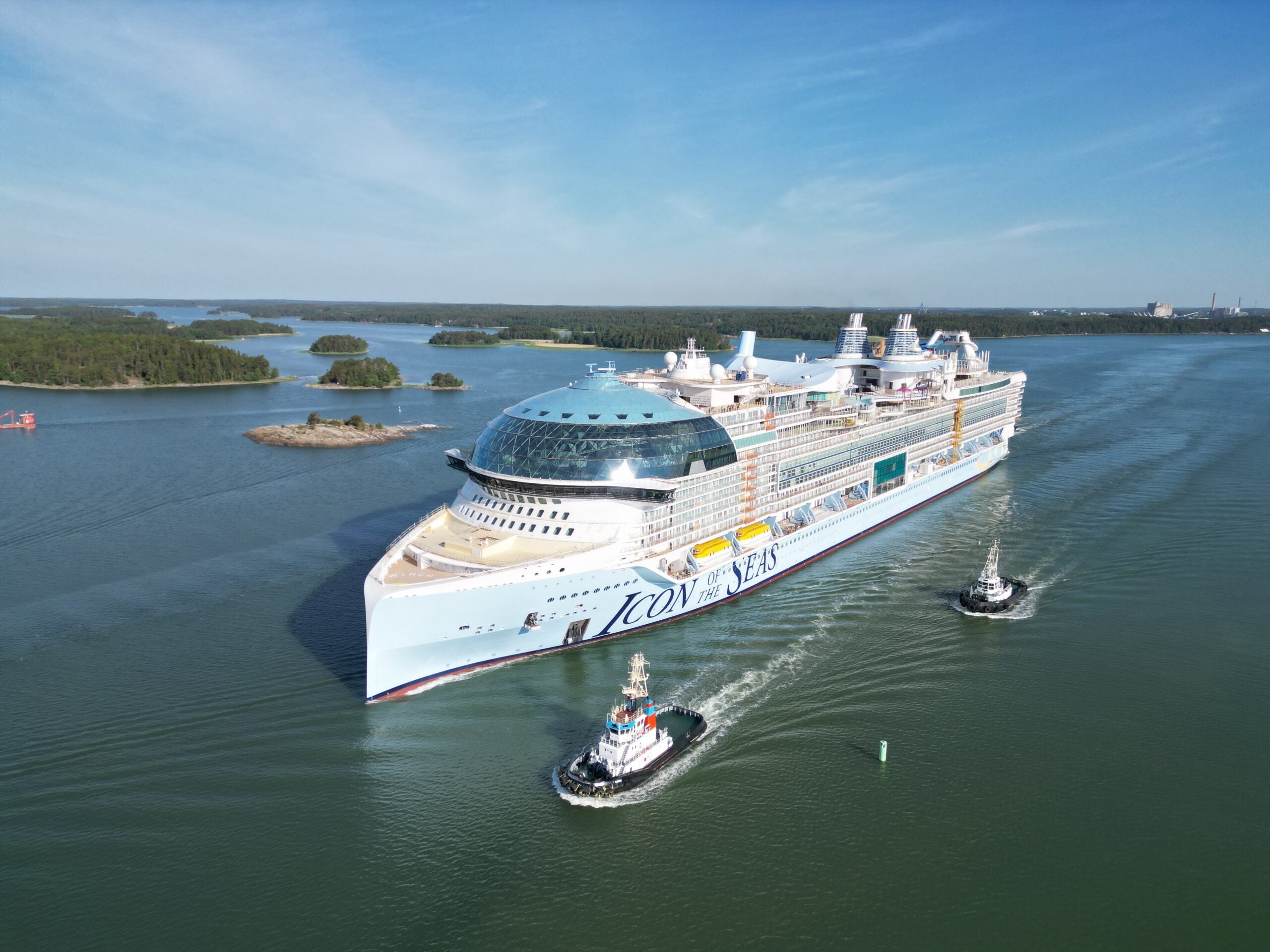
For megaresort fans, there's nothing quite like a Royal Caribbean vessel.
The line's biggest ships are more than 20% bigger than almost any others afloat (only MSC Cruises has ships that come close in size) and feature every type of amusement imaginable, from rock climbing walls and surfing pools to Broadway shows and ice skating rinks.
Families, in particular, will love this line, due to all the family-friendly activities and venues on its vessels. Royal Caribbean ships sail everywhere in the world, but the line's heaviest presence is in the Caribbean and Europe.
Related: The ultimate guide to Royal Caribbean
Another leader in luxury cruising, this seven-ship brand offers all-suite vessels, top-notch service and elegant cuisine.
As with other luxury lines, Seabourn offers a wide range of itineraries around the globe. It also recently jumped into more adventurous, expedition-style cruising with two new 264-passenger vessels designed to operate in polar regions such as Antarctica and the Arctic.
Silversea Cruises
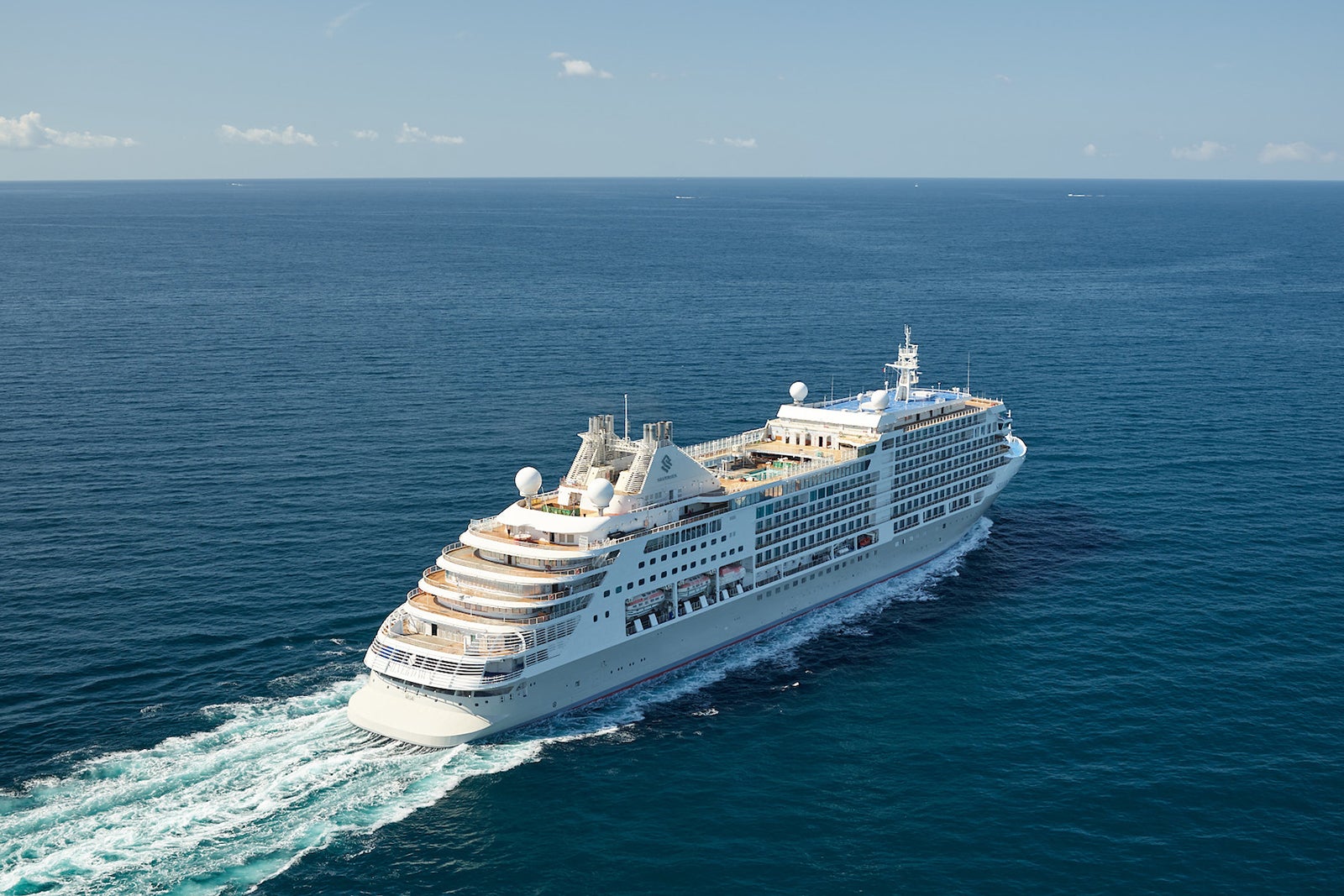
Exquisite service, refined dining and well-appointed accommodations are hallmarks of this Monaco-based luxury line with 12 vessels. Silversea Cruises is also known for its industry-leading array of off-the-beaten-path itineraries.
Its growing fleet of small expedition ships will take you everywhere from the Arctic to Papua New Guinea in style.
The Ritz-Carlton Yacht Collection
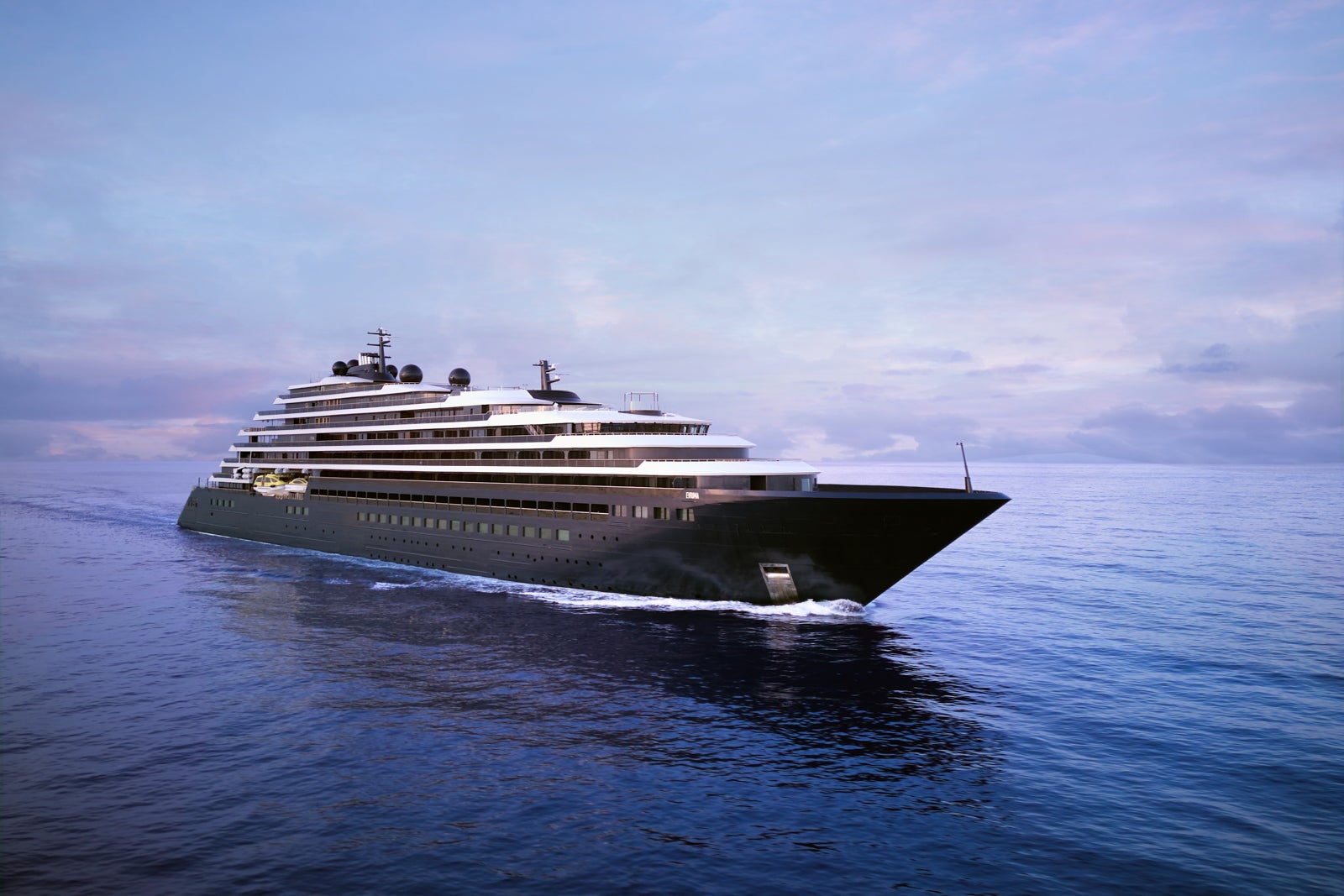
Fans of upscale hotel chain Ritz-Carlton will feel at home on one of this line's yacht-like vessels. Or, at least, that's the idea.
The cruising arm of Ritz-Carlton has been in operation for just a bit over a year, and the jury still is out on where it ranks in the pantheon of luxury cruise brands. The line notably struggled to get off the ground after years of construction delays for its first and only ship.
Dubbed Evrima, the line's only operating ship is a 298-passenger vessel designed to appeal to Ritz-Carlton regulars with an elegant, residential look. A second, bigger ship called Ilma that's already open for bookings debuts later this year.
Related: The ultimate guide to the Ritz-Carlton Yacht Collection
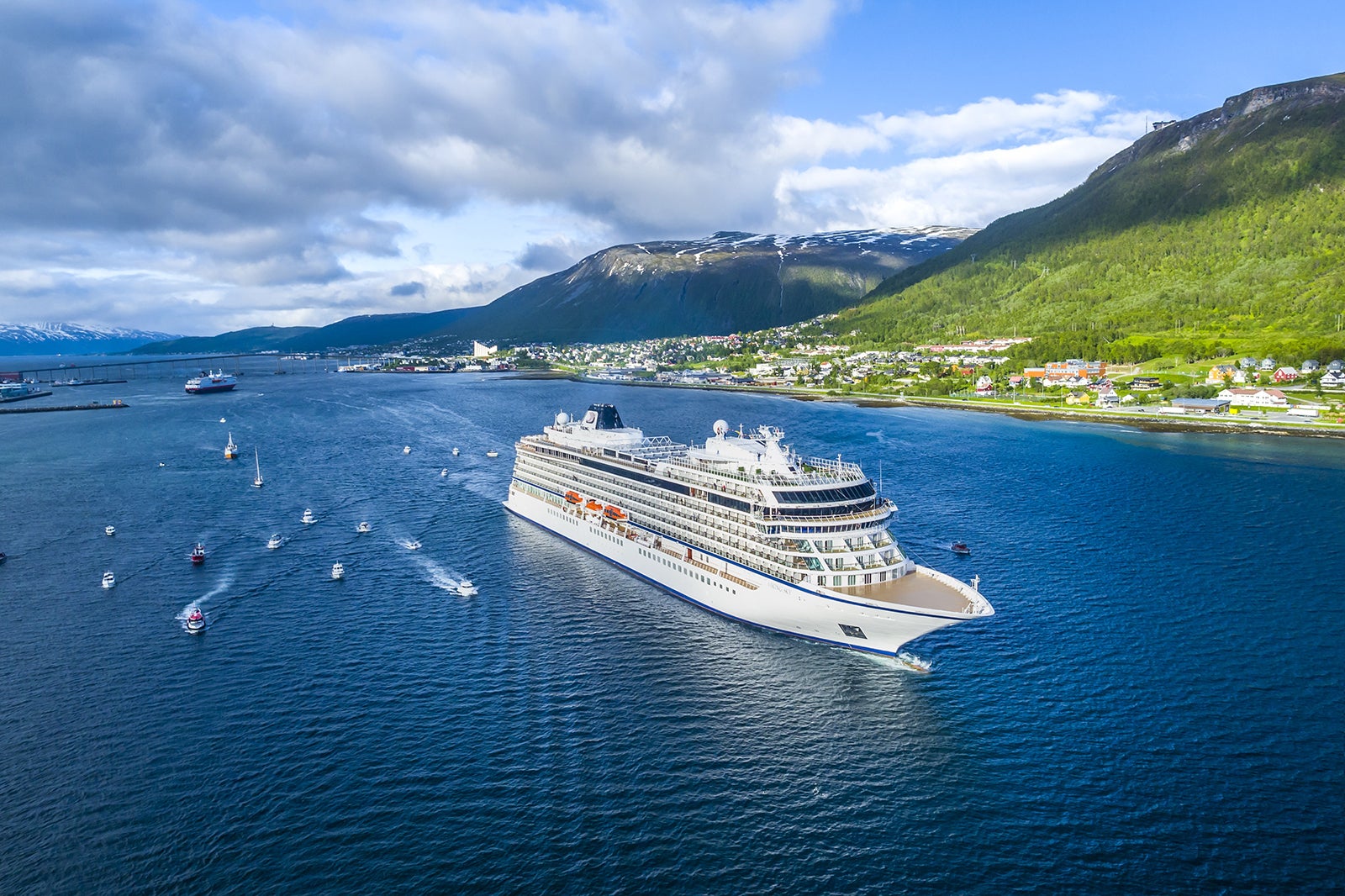
This fast-growing line has dominated the world of river cruising for North Americans for years, and in the last few years, it's become a significant player in upscale ocean cruising as well. Viking 's 80 river ships operate on just about every major river in the world, and its 10 ocean ships (up from just one in 2015) can be found in a growing number of destinations, too.
Viking is known for impeccably designed vessels with modern Scandinavian interiors and offering unusual, port-intensive itineraries. They also operate with a mostly all-inclusive format, as Viking long has subscribed to a "no nickel-and-diming" philosophy. Just don't bother booking the family. Kids under 18 aren't allowed on Viking.
Related: The ultimate guide to Viking cruises
Virgin Voyages
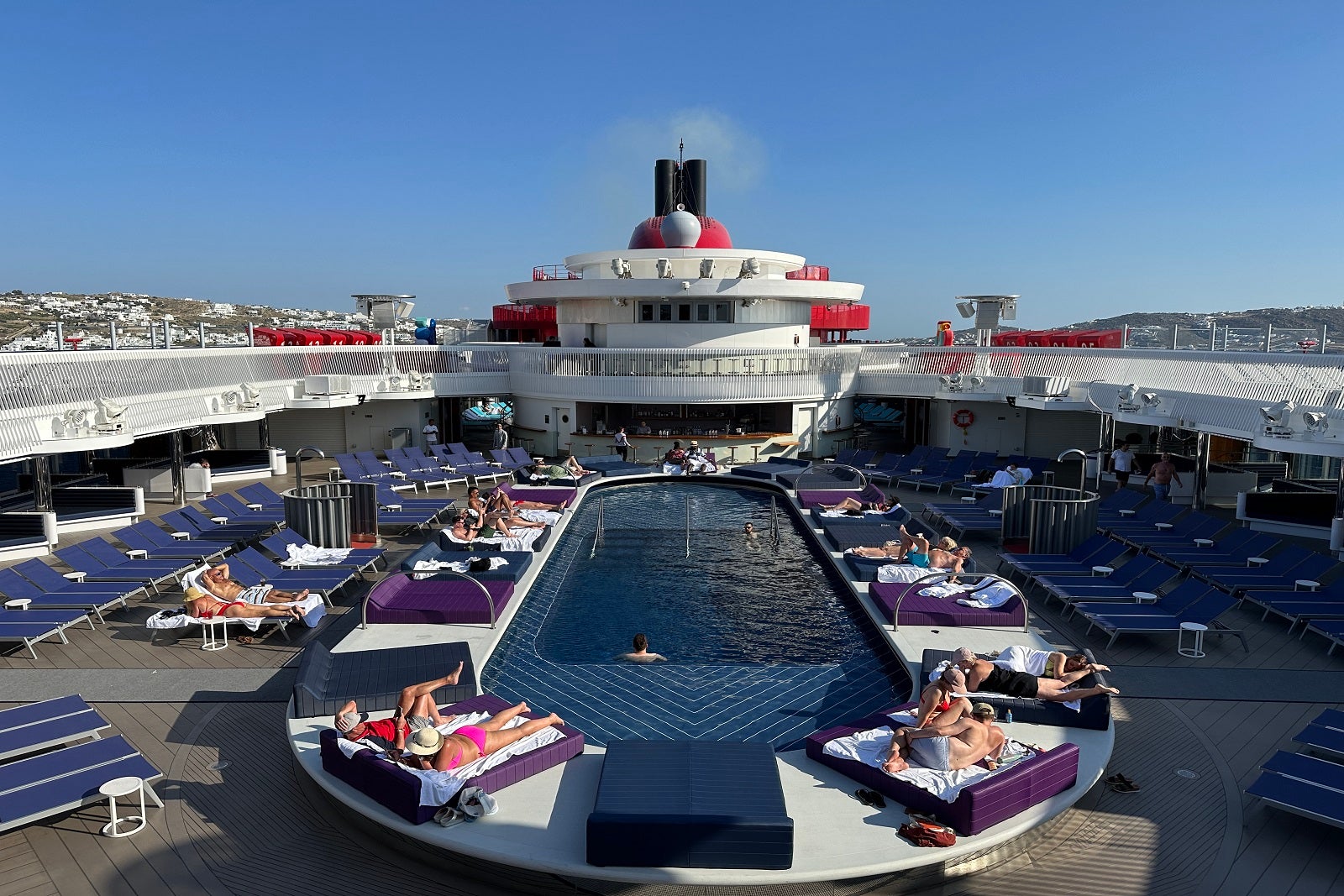
This relatively new cruise line, backed by Richard Branson's Virgin Group, is reinventing mainstream cruising with a hipper, more inclusive, younger vibe (though not too young; its ships are adults-only). Think tattoo shops, karoake booths and no upcharges for tips or eateries.
Virgin Voyages ' first three ships ( Scarlet Lady , Valiant Lady and Resilient Lady ) have suites by acclaimed designer Tom Dixon. Destinations include the Dominican Republic, Mexico and a private beach club in the Bahamas, as well as parts of Europe and Australia.
Related: I've been on more than 150 cruise ships; here's why I loved my first Virgin sailing
Windstar Cruises
If the idea of sailing on a big ship makes you cringe, small-ship specialist Windstar could be the answer.
Its six vessels carry just 148 to 342 passengers — fewer than fit on a single big-ship lifeboat — and are wonderfully intimate.
Romantic types will love Windstar's three vessels with sails — a relative rarity. Foodies can choose one of the James Beard-themed cruises, which include market tours and cooking demonstrations with a James Beard Award-winning chef.
More guides that will help you plan a cruise:
- The 5 most desirable cabin locations on any cruise ship
- The 8 worst cabin locations on any cruise ship
- 21 tips and tricks that will make your cruise go smoothly
- 15 ways cruisers waste money
- 15 best cruises for people who never want to grow up
- What to pack for your first cruise
- Guide to picking a cruise line

Wolf Street
The engines of the largest container ships in the world, and challenges their manufacturers face, by mc01 • may 28, 2018 • 101 comments, the crankshafts may set the limits., by mc01, a frequent commenter on wolf street :.
Three engine manufacturers have come to dominate the market for the giant low-speed two-stroke diesel engines used in the largest container ships, bulk carriers, and tankers: MAN SE of Germany, Mitsubishi Heavy Industries of Japan, and Wärtsilä of Finland.
Stricter environmental legislation around the world is only part of the increasingly more challenging environment these three firms – and the shipyards and contractors they work with – have to deal with.
The shipping industry does not merely demand cleaner and more fuel-efficient engines, but also engines that will last the design life of the ship (usually 25 years) with only scheduled maintenance and minimal repairs. Several shipowners (led by CMA CGM) are coming to like the single engine/single propeller configuration for its efficiency and reduced running costs – as long as it doesn’t impact cruising speed too much.
Technical solutions range from the use of plates of corrosion-resistant materials such as Inconel (a family of nickel-based super-alloys originally developed for jet engines) welded to the piston crown to using crankcase oil to cool not just the pistons themselves but the rod as well to reduce the likelihood of heat-induced failures.
To give an example of what the shipping industry demands nowadays, Maersk’s Triple-E container ships – the largest container ships in the world with a capacity of over 18,000 twenty-foot-container equivalent units (TEU) – are powered by two MAN two-stroke diesels, each driving its own propeller. Each engine has eight cylinders with an 800 mm bore. The engines are designed to deliver their maximum efficiency at 73 rpm. Their combined power of 59,000 kW allows the monster-ship to cruise at 16 knots.
These MAN engines are not the most efficient offering from the German firm, and there are several single engines that put out a lot more power. For example, the much celebrated 14 cylinder version of the Wärtsilä RTA96C is rated for over 80,000kW.
But MAN’s twin-engine configuration allows to reduce engine room size relative to the size of the ship, thus giving more room for cargo. It allows to install one 3000 kW electric generator per shaft, thus almost doubling power from thermal-fired generators and the waste heat recovery (WHR) system.
This increased electricity generation allows each Triple-E ship to carry up to 1,800 climate-controlled containers, a huge boon when carrying heat-sensitive cargo (such as some electronic components) through the hot Indian Ocean.
The Triple-E 25-year design lifespan may be cut short if there are technical breakthroughs that make the ships uneconomical to run, repair, or retrofit. So, just in case, according to both Maersk and Daewoo, the Triple-E were designed to be “easy to break up” when their time comes, but until that day comes we won’t know how much truth there is in this statement.
All of this comes at a price. Each of the three series of 10 Triple E container ships cost Maersk $1.9 billion, bringing the total for all 30 ships to US $5.7 billion in 2016 dollars. This is the largest contract ever for commercial vessels of any kind.
The ferocious competition between Asian shipyards, and especially the Big Three of Korea (Daewoo, Hyundai, and Samsung) allowed Maersk to get excellent financial conditions on hull construction and system assembly/integration. Each ship took about a year to build (Daewoo has large enough facilities to build three such ships at a time). Maersk obtained both a two-year warranty (other shipyards offer one-year warranties) and a so called “tail-heavy” payment: 40% during construction and 60% after Maersk has conducted sea trials after delivery.
Hence it should not come as a surprise that in late 2016 Daewoo was caught in a massive accounting scandal. It was discovered that the firm, instead of being profitable, had accumulated dizzying losses in 2015 and 2016 of 6 trillion won ($4.8 billion). Only a direct government loan of US $2.6 billion in March 2017 allowed Daewoo to avoid bankruptcy.
And challenges in the industry abound.
In 2016 MAN released the result of a study it had carried out at a time single-engine configurations were becoming attractive even for gargantuan projects after the success of the Wärtsilä RTA96C.
MAN said the computer simulations and theoretical studies found only one real challenge for building straight engines with as many as 18 cylinders and pistons with a bore as wide as 1200 mm. As a comparison the largest version of the RTA96C “only” has fourteen cylinders and a piston bore of 960 mm. That challenges, which may become a deal-breaker, is building the colossal crankshafts required for these monster engines.
The largest crankshafts produced so far for marine engines are built in three sections, each of which has to be machined from a huge cast part of forged steel to truly exacting standards of precision.
This photo (via MAN) shows a section of a crankshaft for a large MAN B&W engine. Note the little men under it:
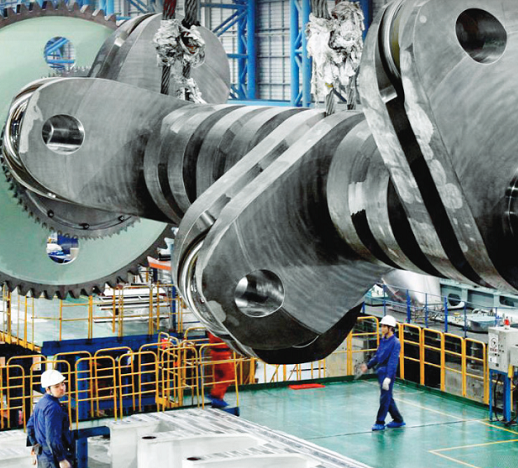
There are only four firms in the world that can cast and machine these crankshafts: HSD Mechatronics and Hyundai Heavy Industries of Korea, Sidenor of Spain, and Kobe Steel (KOBELCO) of Japan. The process is expensive and time-consuming. The crankshaft is by far the most expensive part of these marine engines and, unless there’s some technological breakthrough, may be what will limit the size that piston engines may reach.
Crankshafts are just one of the many parts in an engine that can fail. Modern engines are designed for being mostly serviced in situ. Shipowners now demand most repairs to be carried out with minimal downtime, for example during an ordinary harbor stop.
Companies such as Goltens, to name but the most famous, specialize not merely in offering shipboard repairs but also in-situ machining, annealing, and even line boring to cut this downtime to the absolute minimum and thus allow shipowners to maintain their contractual obligations. The crankshaft from a cruise-ship diesel engine can be replaced in as little as 12 hours during a scheduled harbor stop and without cutting the watertight bulkheads, thus not impacting operations. Amazing.
I hope this gave a small peek into some of the challenges of the shipping industry. The challenges ahead are huge, but human ingenuity seems to know no bounds when stimulated the right way. By MC01, a frequent commenter on WOLF STREET .
The Transportation Boom after the Transportation Recession. Read… Freight Costs, Volume, Demand All Surge across Trucking & Rail, Inflation Fears Heat Up
Enjoy reading WOLF STREET and want to support it? You can donate. I appreciate it immensely. Click on the beer and iced-tea mug to find out how:

Would you like to be notified via email when WOLF STREET publishes a new article? Sign up here .
101 comments for “ The Engines of the Largest Container Ships in the World, and Challenges their Manufacturers Face ”
When I was little kid living in Beloit WI, Colt’s engine plant had a massive muffler outside x2 as tall as the manufacturing building. When they would test fire an engine (nuke sub backup engine etc) the ground in the near vicinity would shake violently.
My wife’s uncle was a machinist in that plant and I have toured it multiple times. The scale of those engines, while not as big as the marine diesels in the article, are incredible!
I was fortunate on one visit to see one start and run. Awesome engine!
18,000 plus TEU’S on one propeller, is not an environmentally safe, ship design.
“… two-stroke …” all in the name of consumption of things…sickening… we really are committing suicide.
It is interesting that these behemoths are still two stroke designs burning cheap bunker oil. Going to four stroke designs would improve emissions but power density would suffer. I’m sure the EPA is working on diesel particulate filter and urea injection requirements for these monsters.
These things are predominantly outside the jurisdiction of the EPA.
They have run on Bunker for so long as to date nobody has stood up and said Hey what about. thissi changing quickly as they will hav e to.
Cheaper and simpler to run them on NG/LPG than add all those emission elements to what must for various reasons, be as simple as possible, engine systems.
More pollution is put out by those ships then all the cars in the world.
They started with cars in the late 60’s.
Think how much pollution could have been avoided, in the following HALF A CENTURY if they had started on international Maritime vessels at the same time.
It is Calculated that Maritime Shipping puts out more pollution than Germany, annual. How much of that is so Corprates can save on labour costs, by exporting jobs to dirty china and india.
When they started on clean air, they first went after Soots.
As you could see them.
They missed CO2 and Methane.
What they still will not admit, is they got it back to front.
First they should have attacked CO2 and Methane, as they were the green house gasses. Instead they stripped away the Soots that were helping to alleviate the effects of the green house gasses by providing a sun screen.
That they made a mistake is not the issue, that they will not admit it, IS.
I’ll try to answer without being too technical.
The reason why two stroke otto engines have such a bad emission record is because the crankshaft bearings are lubricated by oil mixed with the fuel/air mixture. This leads to a lot unburnt fuel/air/oil mix being released into the atmosphere. By contrast two stroke diesel have their crankshaft bearings lubricated by pressurized oil, just like an ordinary four stroke engine. In modern two stroke diesels the bulk of the pollution comes from the fuel itself. Yes, there are ways to reduce it, but when you burn thousands of liters of oil only a little less dense than bitumen per hour you cannot have just baby foxes coming out of the exhaust.
The EPA cannot do anything about these ships, as the US are bound by law to the MARPOL protocol, whose details will be explained in a forthcoming piece. Any change to it has to be negotiated with a plethora of international partners and legislating bodies, like it has been done so far.
California requires container ships to switch to low-sulfur fuel within 24 miles of the coast. In some coastal counties these vessels account for 50 percent of NOx emissions. There is also a speed-reduction incentive program that pays vessels for slowing down in coastal areas to reduce emissions.
Thanks for the post/contribution. Cool stuff, well written.
2 stroke engines are more efficient than 4 strokes, and they don’t use bunker oil. Bunker oil or furnace fuel oil as we called it in the navy is reserved for external combustion engines.
Big cargo ships use various grades of bunker. We’ll post an article on this in a couple of days.
Many fast navy ships have gas turbines — and since before WWI had steam turbines — instead of piston engines, and they use a different fuel.
WWII subs had 2-stroke diesel engines. They were diesel-electrics with no connection between the diesel engines and the electric motors that drove the props.
https://en.wikipedia.org/wiki/Balao-class_submarine
I was basically a tour guide on the Bowfin in Pearl Harbor for a year or so. Diesel boats are cool!
The Titanic had triple expansion reciprocating engines for the port and starboard screws and a a centerline turbine for the center screw. The business decision to compete on luxury and size rather than speed drove this design.
“2 stroke engines are more efficient than 4 strokes, and they don’t use bunker oil. Bunker oil or furnace fuel oil as we called it in the navy is reserved for external combustion engines.”
In the NAVY being the words of relevance.
Which is why the Japanese cried, when the last US diesel fueled carrier stationed there, was withdrawn
Two stroke engines have a simpler valve train, but require a blower in order to combine the intake/exhaust/compression strokes into one. They run at slower revolutions/min which is probably a necessity to completely burn the cheap and heavy fuel oil. Slower speed also allows the engines to connect directly to a propeller without a transmission between.
I think big diesels run slow for two reasons.
Because diesel fuel is injected at a metered rate it takes notable amount of time for it to burn completely inside the huge cylinders. And because at that scale the mechanical resonance of the engine parts are low frequency. So if you ran it fast, it combustion wouldn’t complete. And harmonics in the engine would destroy it.
The Wärtsilä RTA96C operates at 22-120 RPM! To put that into perspective, Otto-cycle (gas) car engines idle at 500-1000 RPM. Bore and stroke are 37.75 in. by 8.4 ft, so a man could stand inside of the combustion chamber with room to spare. Every other cycle is a power cycle in a 2 stroke engine, which allows them to run at a slower speed.
Here is an instructor presenting a Detroit Diesel 2-cycle engine: https://www.youtube.com/watch?v=rws_2kFahBI
Thanks MC01. Interesting information. Two-stroke diesel? Sounds like a pollution machine.
The sweet spot of over the road diesel engine technology was around 2000-2004 with reasonable emission requirements and excellent fuel efficiency. With tier 4 and later emission requirements, fuel consumption went up about 8-10% and maintenance costs surged due to exhaust gas recirculation (EGR), diesel particulate filters (DPFs) that require raw fuel injection into the filter to burn off particulate and Urea injection.
There is such a thing as regulatory overreach. You know what I’m taking about if you have ever used one of the new EPA mandated fuel canisters. I have spilled more fuel with these vent-less contraptions. Good thing they can (still) be retrofitted with the old spouts and vents.
RE: single engines on monster ships. Some experts in maritime disasters disapprove of a single power source. They don’t fail often but they do, and then the ship can only drift.
At least in theory, though, nowadays if the engine quits they can yelp for help on the radio.
Nick makes a good point. When one quits it’s typically in the midst of a raging storm. Good luck with a phone call. A very excellent article and commentary, Wolf.
Nick, Another good topic to explore is the economics of sea-going tugs….
“Nick, Another good topic to explore is the economics of sea-going tugs….”
What Economics, Ocean salvage tugs are a necessity. Economic High performance, is an oxy moron.
You buy fuel, a calculate usage, by the 10’s of Tons.
Any salvage or heavy weight service Vehicle or Vessel is inherently fuel inefficient, due to the tasks it is required to undertake.
One I worked on was required to regularly undertake a 1 hour full power pull test.
They tie it to a bollard on a Warf/Pier then (Try) to operate it a full power for 1 hour.
Normally it fails then gets a calculated pass after an argument as normally after about 20 minutes it pulls the end off the Warf/Pier down or pulls the bollard off the end of the Warf/Pier.
When Empty, not towing, in good weather, it could attain Maximum hull speed on 1 of its 4 Massive Detroit/MTU Turbocharged Engines.
The only trouble we ever had with those engines was Cylinder head cracking, as Detroit cast a faulty batch of heads, and we had some. They replaced them as they cracked, under warranty. Time consuming but not difficult job replacing them as it had a large engine room.
Basically it was a floating engine room, with fuel-tanks (2000 tons plus was the smallest), and a winch attached to it.
That type of vessel can tow loaded 20,000 TEU carries around the world, and laugh.
Based in Australia now, used to be based in NZ, till the Aussies brought the company. They Demanded the crew base in Australia, as a way of getting rid of most of the Non Aussie members. No money on that Job for the workers, at Aussie tax rates.
Most off us on it, were previously officially stateless for tax purposes.
Now we need to work on cleaner Fuel Usage Issues. IIRC, the “cheap and dirty” Fuel were used in Intl Waters. Pity the Petroleum KleptOchlarchs killed off Mister Diesel, who designed his engine to run on Plant based Oils.
Generally speaking, Conventionally Powered US Navy Ships used a standard quality of what we referred to as DFM – Diesel Fuel, Marine; and comparable quality fuel were purchased when abroad.
After Retiring from a 20 Year Active Duty Career in ’61, my Late Father spent his 2nd 20 Years for the Navy in the Auxillary Fleet of Tankers, Oilers, Oceanographic, and Supply Ships manned by Civil Service Sailors.
I recall him giving us a quick tour of some of his Ships he worked onboard. He even Sailed to Antarctica on Operation Deep Freeze once.
Funny seeing years myself as a young Logistics Ensign on a Cruiser in the same Fleet, same Port, and Refueling off the very Ships he used to Sail on. My Father Retired from the Aux Fleet a few years before I became Commissioned. I had a few Midshipman Cruises in the Pacific; but they were on Nuke Subs.
Fate sent me back home – I was all set on chasing Bikini-clad Dames in SoCal or Hawaii; but Logistics School Options had Seal Team Six, Nuclear Reactors Support – yet no Attack Submarine (Father was a Submariner) or F-18 Squadron. I was in an Ensign Pool until someone in Japan was fired. I spoke the Language, I suggested they send others who never left their home state before joining the Navy, yet they sent me anyway.
I Sailed the Seas, even into War Zones on Convoy Duty (Iran-Iraq War), and at the end of my Tour, helped my Parents move to the States.
Even had one of those Massive Tankers we escorted save us from a Mine (Bridgetown). Prior to that incident, a Warship took the Lead Positon of Convoys.
I was hoping for some, hard, accurate, unbiased, fuel consumption and emission Data.
Also so comparisons between normal Diesel, and Bunker oil fueled vessels.
From more accurate Sources, than those found in Search.
Maybe in another article.
We’ll publish an article on bunker in a few days. I already have the draft in front of me. These are big topics, one at a time.
Fuel consumption figures depend to some extent on the ship and speed. Just a like a car. You can put the same engine in a compact car or in an SUV, and fuel consumption will change a lot (weight, aerodynamics etc.) Similar for ships. There are specs for how much fuel a big diesel like this burns in an hour, but that’s just fuel consumption per hour. Fuel economy involves what it accomplishes with this amount of fuel over this time period. A ship with better fuel economy might haul more payload over the same distance at the same speed, and versions thereof.
After we publish the somewhat complicated article on bunker, MCO1 might consider doing an article on fuel economy and the issues involved, including speed, size, etc. One topic at a time.
Thats good.
This area (Bunker) is important and has been missing in the Warming debate, Environmental regulations, for far to long.
After doing a bit of research on these engines, and reading the Wartsilia webpage on the RTA96C, I figured that:
The Number 6 or Bunker C HFO has a density 1.010 g/cm3 The engine is at maximum efficiency of 160 g/kWh Using MC01’s efficiency rating of 170 g/kWh, the Emma Maersk (powered by this motor & commissioned back in September 2006) when running at 60% power uses 13,736 kg/hour In a 24 hour day at this 60% output, it adds up to 200,000 kg of fuel used.
The RTA96C has a rating of 80,080 kilowatts and using the conversion of 1 horsepower = 745.7 watts, that’s 1078,389 ponies!
What can I say, I’m a semi-retired motor head with a physics degree who likes to crunch numbers.
Gotta re-read my notes as 13,736 kg/hour is at maximum output. At 60%, with 170g/kWh efficiency the number is 8,240 kg per hour.
Thank you MC01 and Wolf for publishing this!
Ok, one more correction 107,390 hp.
Great article. Thanks Wolf for posting.
MCO1: What happened to Sulzer Brothers of Winterthur, Switzerland and Burmeister-Wain in Copenhagen? Are they out of the business of large diesel engine manufacture?
Crankshafts: The process of manufacture, I witnessed at Kobe steel in Japan was as follows: The crankshaft journals, webs, and crankpins were forged and machined as separate pieces. The crankshaft was then built-up vertically by heating the webs and shrink fitting them to the crankpins and journals. The mating parts being highly polished to secure a good contact of fit. I asked how they could assure the accuracy of the angles of the throws by this method? They told me they just had to get it close, as the engine had adjustable cams operating the fuel injectors and any angular error in the throws is corrected by the fuel cam adjustment.
Fuel Consumption: A ships fuel consumption varies as the cube of the speed. Double the speed and you will burn 8 times the amount of fuel. I worked on a steam turbine powered ship (36,000 shp) which burned about 200 tons/day at full power. Current fuel prices for bunker fuel are about $425/ton at Houston. 200 tons = 1300 bbl. = 55,000 gal./day which translates into $85,000/day fuel costs. Serious money. A large bore diesel of the same horsepower will burn less than 1/2 that number. You can see why they are used.
Sulzer doesn’t make an engine of its own of that size. The Sulzer engine you might have in mind is Wärtsilä-Sulzer engine that is discussed in the article as the “Wärtsilä RTA96C.”
Burmeister & Wain became part of MAN in 1980. Hence the “MAN B&W,” whose crankshaft is shown in the photo in the article.
I could tell you, but then I would have to kill you. In horrible, horrible fashion. ;-)
The first thing I told myself when writing this piece was to avoid being too technical. This is meant to be an introduction, not a direct comparison between engines, propulsion systems, hull types and auxilliary systems such as waste heat recovery. If you need such a thing you probably already work for Maersk, MSC or COSCO. In which case I need to ask: just how long do you expect the China trade to keep on growing at this pace? ;-)
It’s a very good, and interesting, article. Thanks.
What came to my mind was the lack of diversity in manufacturing.. Only one firm is outside the area of potential conflict with N Korea can manufacture these big cranks. Just another glitch in globalization.
This is not a glitch. In fact I am surprised there four firms able to do this job and not just one.
The reasons are simple: the investments, facilities and know-how needed to manufacture these things are simply staggering. These modern crankshafts have each throw manufactured from a single casting (semi-built crankcases) while in the past each throw was assembled from separate webs and crankpins (fully-built crankcases). Consider that each throw can weigh more than ten tons and has to be machined to truly exacting standards of precision. Just to give an example the bores for the main journals (which are shrink fit) have an allowance of less than 1/600 of the diameter.
In the late 80’s MAN tried to introduce welded crankshafts, which used much smaller cast parts and had the advantage of continous grain flow (meaning the crankshaft could be made lighter without sacrificing reliability). The submerged arc welding system used was a true wonder of engineering. Yet MAN stopped after just twenty crankshafts. Why? Because the process was so expensive it could not compete with neither fully-built nor semi-built crankshafts and, albeit these crankshafts have proven very reliable, the extra cost could not be justified.
I wonder if these crankshafts are a future candidate for 3d printing?
I am too old and stodgy to really get into 3D printing. As Confucian scholars are wont to say “We have to leave something for future generations to do”. Plus I was trained as a chemist, not as an engineer or CAD designer, so all my knowledge about 3D printing comes from hearing other people talk or the occasional piece I read.
I know there are now several prototypes of metal 3D printers that are designed to work on very large pieces, up to one metric ton in weight. I have no idea how close these prototypes are to being even remotely commercialy viable nor of how they compete with casting and machining when it comes to the bottom line (costs).
Mind these crankshafts are usually made from HSLA (High Strength Low Alloy) steel, not the nodular cast steel now favored by the automotive industry for the same applications and I haven’t heard about HSLA steel being used in 3D printing so far but, as said, I am not exactly in the loop. I hope some young up and coming engineer or metal chemist will drop in soon to fill us in with the details.
In a prior life I worked for a group that manufactured machines that used large one piece forged cranks. Largest crank was around 15 tons with counterweights and 20 inch throws. That’s small compared to those marine diesel cranks. Even with the ‘medium’ sized cranks, the number of manufactures are pretty limited and the price is pretty high. At one time the USA had shops that could build those cranks. That’s long past.
We had looked at Vítkovice Heavy Machinery in Czech Republic. They were doing large cranks for marine engines at the time. Don’t know if they still are. We eventually settled on assembled crankshaft using oil injection method for assembly. This lowered the crankshaft cost by 40% and allowed the use of lower cost one piece bearings on the throw pins and center mains.
This was like watching a documentary, interesting but in the “I will ever need to know this for trivia” kind of way.
Thank you for the information. I had no clue container ships were so expensive.
Now even if Wind power and Solar power starts to become way cheaper than any other fuel source in a few years, these ships will still need fuel.
Looks like transport in the sea will be lagging behind about being green.
And where are the solar powered trains dang it?
“Three engine manufacturers have come to dominate the market for the giant low-speed two-stroke diesel engines used in the largest container ships, bulk carriers, and tankers: MAN SE of Germany, Mitsubishi Heavy Industries of Japan, and Wärtsilä of Finland.”
“There are only four firms in the world that can cast and machine these crankshafts: HSD Mechatronics and Hyundai Heavy Industries of Korea, Sidenor of Spain, and Kobe Steel (KOBELCO) of Japan.”
That is just one example of how dependent the U.S. is on foreign heavy industry. We can only go so far on tattoo parlors, law firms, nail salons, check cashing stores, and Snapchat.
My interest was centered on the same two statements. It brought to mind the old Bethlehem Steel plant in Pennsylvania. I got to see it before it was dismantled and turned into a casino. I hope that casino can make up for gaps in the global supply chain when all hell breaks loose.
I remember reading somewhere that there is no longer a U.S. producer of the transformers used in the electric grid and that the majority are made in Korea, with a very long lead time in production and transportation. To say that our politicians have dropped the ball on critical parts of national security infrastructure would be an extreme understatement.
That is true, Even GE Canada and GE Brazil have now gone out of that business. A very serious problem. the lead time for a big transformer is 18 months or more.
This would be a security issue only if the US was embargoed for years by all four. This niche business is not typical of the machine industry, it is highly unusual. Very unusual size cranks, with two or three customers. It would make no commercial sense for a fifth player to enter, unless of course it could get tariffs on the other four.
Then there is the plight of Hershey that is supplied with that ultra-thin foil for chocolates by a foreign outfit, which may be hit by tariffs. So just do it here? It wouldn’t make sense. You would split the niche with the other outfit which is selling world wide, leaving not much for either of you.
Long ago Ford almost got itself in trouble with vertical integration: ‘we use steel so we should own steel mills. The steel mills use coal so we should own coal mines etc.’
But I agree with your main point: the structure of the US (and Canadian) economies is out of whack. One point from today’s Globe and Mail: the size of the total real estate sector: construction, financing, sales, legal etc., is now two standard deviations from the historical mean.
It’s never been that big before. The article giving that info adds that it is now impossible to have a correction to the norm in real estate without: ‘Best case: a 2008 (not as bad in Can as in US)….or
Worst case: highest unemployment since the Depression’
PS: total RE sector is total Canadian sector.
One thing that makes the U.S. unique at the moment is the sheer amount of capital being burnt up in obvious scam companies like Tesla, Snapchat, Netflix, Uber, etc. and on spending of dubious value like student loans for college. When capital is destroyed this way it crowds out spending on key capital assets that are important for a nation’s long term success.
I don’t think any other country can match the U.S. in this ignominious distinction!
Very interesting article. Thanks MC01
Facscinating and worthwhile, MC01; thanks for the article!
Let me second that John. Wolf’s blog is countering our rapid degeneration into a cargo cult.
I see what you did there
Very very interesting article. I realize such low rpm and finely machined components ensure that engine failure is unlikely, however, two engines might keep one of these monsters off the rocks. massive sea-going rescue tugs aren’t always readily available in most of the world.
Just my opinion, but it isn’t enough of a reason to cite expense and high seas to get a pass on pollution. Bunker C is way past its time and mankind needs to power transport with cleaner fuels.
Of course I can name a major consuming nation whose leadership does not accept climate change and is actively promoting coal. Oh well.
Thanks for such an interesting read.
The single/double engine issue is very similar to the number of engines used in jetliners.
Still in 1980, when Airbus had already been selling the A300 for four years and Boeing was designing the 767, the idea that twinjets could carry passengers safely over the Atlantic, let alone Pacific, Ocean was still so outrageous even the FAA was publicly against it despite the damage it would have caused to Boeing, Pratt & Whitney and General Electric, all US companies with very strong lobbying arms. Then came ETOPS and now twinjet widebodies such as the Airbus A330 and Boeing 777 are the mainstays of long-distance flying. These days Korean Air flies their Dreamliner twins non-stop between Madrid and Seoul three times per week, with a flying time of over 12 hours. Nobody bats an eyelid.
Shipping companies such as Maersk and MSC know perfectly well the costs of having a stranded ship. Insurance, recovery, repairs and especially making customers whole are not merely big but huge costs that need to be cut down as much as possible otherwise they’ll impact not merely financials but operations as well. And as COSCO learned, environmental cleanup and fines can add a big fat layer of costs.
Here is one way it’s different. A modern twin jet can fly on one: the old regs were for piston twins that could barely do so.
So two minus one is one. which is doable. But one minus one is zero, which is a disaster.
In 1954 the FAA restricted jets with less than four engines specifically to never being more than sixty minutes of flight away from an airport. This was the so-called sixty minutes rule and the reason why Boeing developed the 720 from the 707 for medium range routes as a stop-gap measure while they worked to have FAA wave this rule for three-engined aircraft. This paved the way for the highly successful 727, the successful McDonnel-Douglas DC10 and the… well, not so successful Lockheed Tristar, the aircraft that almost sank Lockheed and Rolls-Royce at the same time.
Your article was nicely written but it has a few inaccuracies or slight omissions that generated several comments which made me chuckle.
Number of Main Engines; Not sure why the article makes an issue about ships lacking main engine redundancy, as if this is something new. I believe using an airplane to be a very poor example. Ships are not on par with planes when propulsion is lost. As i understand it, hydrodynamic platforms float on liquid. While aeronautic platforms require fluid flow over the wing to stay aloft in air. In short, lost propulsion = ships float and planes crash.
Historically, the vast majority of large commercial ocean going deep sea bulk, container & tank ship vessels are propelled by a single fixed screw, single direct connected multi-cylinder in-line slow speed 2 stroke direct reversing crosshead type diesel engine. This is based upon pure economics of cost/profit, from construction/operation and return due via viable freight space. Passenger ships utilize multi-engine diesel electric configurations due to flexibility as they have a very high “hotel electrical” load, strong need for lower propulsion to hull vibration transmission and the ability to disperse power generation away from having a large single central space, as other forms of ocean freight transport employ.
I’ve also worked on some what smaller vessels (650 foot long) that utilized multi-diesel 4 stroke medium speed engines that either had 2 engines clutched to one set of reversing/reduction gear (efficient engine speed is higher than efficient propeller speed) or it had a CPP (controllable pitch propeller) or twin screw where each medium speed engine had its own reversing/reduction gear coupled via clutch to its own propeller line shafting. When compared to a direct coupled slow speed diesel, each multi engine arrangement requires more equipment and sub systems for support, which take up potential cargo space, have higher initial costs for procurement and installation along with increased life time maintenance costs. Its cheaper and law of average for component failure being lower to maintain 1 huge 9 cylinder in-line main engine then 2 smaller V-18 cylinder type main engines.
Bottom line; large 2 stroke crosshead type diesel engines obtain higher combustion efficiency vrs 4 stroke trunk type engines, while producing more power per combustion cycle. This is mainly due to crosshead diesel engines aren’t hampered by stroke to bore ratio limitations like 4 stroke trunk type engines suffer from. The longer the piston stroke, more power is extracted from the heat of combustion as the expanding exhaust gas can impart more downward force longer, thus more torque to the crankshaft throw is imparted, which in turn performs the mechanical work of a rotating crankshaft. Large slow speed engines have a typical stroke of 8.5 to 10 feet, with the piston & its rod reciprocating vertical. The piston rod is connected to a crosshead, as it accommodates the oscillations of the upper connecting rod while the big end orbits around with the crank throw pin. In a trunk engine, stroke length of the crank throw combined with con-rod oscillation over its length from piston to big end, has the limitation of not striking the cylinder wall. Every diesel engine has the majority of its power developed where maximum piston velocity occurs during the power stroke, typically its around 90 degrees ATDC.
Large slow speed main engines are direct reversing … meaning the firing order can be changed which in turn will change the direction of flywheel rotation. Example; in-line 6 firing order is 1,5,3,6,2,4 for clockwise rotation to go ahead. Changing the order to fire 4,2,6,3,5,1 will cause the crankshaft to rotate counter clockwise, providing astern direction. On older engines this is done by either rotating (90 degrees) or sliding the fuel pump cam to another set of lobes. On current “cam-less” engines its done electronically via manipulating hydraulic devices that would take way too much time to explain here.
Why does it run so slow; Because of the engine’s physical moving parts size (6 foot long crank shaft throws orbiting around 3 foot diameter main journal bearing pins, 3 ton oscillating 8 foot long con-rods, with 1 ton reciprocating crossheads and a 10 foot long piston rod weighing 2 tons, all comprise each cylinders running gear) material of the rotating mass inertia and harmonics are what dictate the rotational speed range of the flywheel. Which on large slow speed diesel engines coincides with the efficient speed of the propeller (aka, screw). For the largest of slow speed diesel engines, they tend to max out at 102 RPM, with slightly smaller bores and much shorter stroke engines maxing out around 120 RPM. Both numbers mean very little with respect to fuel consumption per distance travelled unless compared to the propeller curve. As the actual engine load and developed cylinder mean effective pressure are taken into consideration. Not following the prescribed PM schedule and/or operating a main engine over loaded in the prop “B” zone for an extended period of time, lead to component failures. So, a ships engine power requirements stem from the need to rotate the propeller and the propeller size/blade pitch are predicated on the vessel size and designed service speed. When required horse power is determined, its the cart before the horse method.
Fuel: Modern slow speed crosshead and medium speed trunk diesel engines are built to burn the dregs of the crude oil refining processes. There are large slow speed dual fuel diesel engines that can burn a high percentage of methane gas using a diesel injector pilot arrangement for combustion of both but unless LNG is the cargo, there currently lacks a full global commitment of infrastructure to support gas consumption at this time but markets are developing and methane is the future. But for now, they are incinerators burning the by-products of consumer useful fuels. Its called HFO (heavy fuel oil) with a viscosity index number (ie. HFO 380), which is basically an unstable blend of asphalt with lighter distillates and full of impurities that requires extensive processing on board the ship prior to injection and combustion. This is done by heating, centrifugal separation and filtration. However IMO (International Maritime Organization) via international treaties have imposed limitations on HFO sulfur content globally and established zones where either ultra low sulfur (distillate fuel only, like #1 fuel oil), fuel must be used or exhaust scrubbing systems be employed which also help vessel operators meet IMO global regulations for Nox and PM emission limits. In California and elsewhere local environmental laws impact normal plant operation, several operators utilize “cold iron” where they shut down the ships power generating diesels and plug into the grid via a source on the dock using a retractable power cord.
Might as well mention how main engine exhaust gas generates steam in a stack boiler, used to heat the HFO and which can be (is on some plants) used to spin a stand alone steam turbine generator, which supplies a main power buss, that in turn can apply power to the main diesel engine propeller line shaft motor/generator arrangement …. which can also generate electrical power to the main buss depending on total refrigerated container electrical load while keeping the main diesel generators secured. In other words it can be operated as a generator driven by the main engine to keep other diesel engines off line or operated as a electrical motor to impart power into the propeller shaft so less fuel needs to be consumed for propulsion, depending on the total electrical load and desired speed of the ship to meet its cargo delivery commitments.
Typically on modern vessels 4 licensed engineers with the assistance of 3 unlicensed crew members hold the responsibility to keep the plant in operation and perform the engine maintenance. On modern ships when they arrive in port, its time for the engineering staff to hit the deck with tools in hand to perform main engine inspections and overhauls. Its rare to get ashore.
I’ve been a licensed marine engineering officer since 1975, holding a globally recognized endorsement for unlimited HP as CE for both steam and diesel propulsion modes. I’ve worked in several shipyards in Europe, America and Asia along with witnessing large slow speed engines being built at HMD in Ulsan Korea, and hope the above has helped fill some gaps the article may have created. I’ve worked in a few refineries too, so I’m looking forward to your fuel article … roll of eyes, with a smile.
Red Beard, I don’t know if you are a regular follower or tipped this way from one of our readers due to your experience, if so, welcome aboard (pun intended).
These mega ships forced the Panama Canal to undergo a lengthy and expensive expansion. https://en.wikipedia.org/wiki/Panama_Canal_expansion_project
When all is said and done, its still profitable business that foots the bill for these engines and indeed, the very ships that they are in. Utilizing weekly five year charts of some of the largest seaborne carriers, the touted global recovery meme does not hold water. (pardon the pun)
As a for instance, the Baltic Dry Index (BDI) 200 DMA weekly over five years long term trend, is down and has flat lined. The Diana Shipping (DSX) five year weekly trend is down and has flat lined. Finally a small ray of hope, with Hapag Llloyd (HLAG) which has slowly been grinding up, but has flat lined since this past Autumn.
So much for the “synchronized global recovery” fairytale. Many of these ship building maritime long term loans, will find themselves underwater (pun intended) if global commerce conditions get any worse. Along with their creditors (banks) that hold the loan paper. Could be that will be all they own at the end of it – worthless paper.
Banks have probably sold that off too, the criminal FED bailout gave them their out opportunity to sell into strength.
Thanks for the article on these monsters, MC01
Very interesting – so few places can make these crankshafts!
smaller engine teardown, still impressive!
https://imgur.com/a/k94WmHt
A fascinating read. We need more of these. ;)
Great piece. I would like very much if something like this was a regular feature on wolfstreet.
MC01, are you getting the message?
I read “regular” as in “when you’ll be retired or days will have at least 36 hours”. ;-)
This was a amazingly wonderful posting – many thanks from me too for the time spent in pulling it together.
Very informative and very enjoyable read. Thank you..
agreed. very interesting article
These are fuel-injected 2-strokes, no doubt. That makes a huge difference concerning the unspent fuel emissions that gives the typical 2-stroke it’s reputation.
Two stroke diesels have always been fuel injected. When Doxford, JuMo and Detroit Diesel started to make them popular mechanically-actuated unit injectors were used, just like on ordinary diesels. Then came Electronically Controlled Fuel Injection (EFI) and finally Common Rail.
By contrast the challenges of making an FI two stroke otto cycle engine are huge. The reasons for this is that in a two stroke diesel the crankshaft bearings are lubricated by pressurized oil, just like on a four stroke. By contrast an otto cycle two stroke engine needs oil mixed with the fuel air mixture and circled through the crankcase to lubricate the bearings. This leads to the reason why two stroke are such dirty engines: a large part of that oil/fuel/air mixture is dumped back into the atmosphere.
Fuel injection for otto cycle two stroke engines have always been a sort of engineering Holy Grail. Honda, despite their general lack of interest in these engines, was the first company to have a workable EFI which they used on some racing motorcycles in the 80’s. In more recent years Kokusan Denki developed a three-injectors system for two stroke engines which showed some promise and was commercially used in some commercial motorcycle engines before the plug was pulled due to a change in ownership. Stihl of Germany is presently the only manufacturer offering a commercially available otto-cycle FI two stroke in form of cut-off (concrete) saws.
Great contribution. And I thought making optical cables eas the marvel of engineering. Can domeone write such contribution?
https://newatlas.com/shipping-pollution/11526/
Link above for info on ship fuel consumption. It is this type of information that makes the whole climate change seem totally insane. Somehow it is efficient for a Pakistani to make my shirts and ship across the globe using these monster ships to my nearby friendly retailer… such nonsense .. 15 of the largest ships emit the equivalent emissions of 760 million cars … amazing vessels but the global trade meme is simply global labor exploitation
I am not Happy with those sort of sensationalist numbers which is why I asked for truthful unbiased ones.
I worked on a Four engine salvage tug, with detroits for a while, we used tons of diesel an hour. when working, those numbers dont sound wright.
The emissions from those bunker fueled container vessels are bad, but not that bad.
The emissions are really, really bad, as attested to by the soot we get through our windows here in San Francisco. The winds nearly always come from the West (Pacific). The nearest industrial installation west of our building is in Japan. We have one of the windows open almost all the time, and the amount of soot that settles on the window sill in just one week is just stunning. We suspect that it is from the shipping traffic into and out of the Bay. The container ships going to the Port of Oakland pass about 1.5 miles from the window. The tankers to and from the refinery terminals in Richmond pass by several miles away. Other bulk carriers vary.
Yes re: SF soot. Not to mention the West Coast version of the “Paris Hack”.
They are most defiantly obscene.
This I know.
The point being you can not have a real debate based on false numbers and half truths unless you are P 45 and all that is false goes your way.
I have plenty of, Torque, Hp, Fuel consumption per hour, at any given rpm charts, for small marine engines. Which can be used to calculate the emissions with reasonable accuracy for entities that will not give out that data.
Thats the DATA required for the argument around bigger engines
That accurate information for the engines in question, is there, it is just very difficult for the non-connected to obtain it. For the reasons your nose, in proximity of your open SF Bay window, tells you.
Try sailing behind one, on the downwind side.
BE CAREFUL how you clean and dispose of that soot.
IT IS CARCINOGENIC.
All the nasties in crude that are not wanted in anything else, and not destroyed in the combustion process, end up in that Soot..
In the bay the engines will not be at premium operating temperature, and speed, so emitting more unburnt fuel.
In our Harbour (One of teh best boating Harbours in the world) we are lucky, predominant winds, are offshore.
Wolf, how close are you to the Bay Bridge? The trucks pouring over there could add to the soot.
I can see it in the distance :-]
We’re above Aquatics Park, about 2.5 miles or so north-west from the nearest part of the Bay Bridge. And since the wind almost always comes from the west, the nasty stuff from the Bay Bridge is not something we have to worry about, thank goodness.
I understand your sentiments regarding the numbers but I tend to believe the numbers are close to the truth. That was the first article I had seen regarding the topic and didn’t paint the rosy picture of these monster ships. I was a propulsion engineer for turbine engines on aircraft not diesel engines on maritime vessels (22k lbs per hr per engine @ takeoff thrust for 747-8 engines)
This is something I can relate to. 22k lbs./hr is about 230 tons/day which is close to what my ship consumed per day.
This link has numbers similar to the LiveBunkers link I posted a week ago in response to MC01’s comments on the ‘Freight Costs, Volume, Demand …’ feature which triggered this feature on engines. It also mentions the Emma Maersk which I did some calculations on as I posted earlier.
Assume that the Emma Maersk is running its 14 cylinder engine at 60% of its potential power output and is running at a high efficiency, but not maximum efficiency; say it’s at 170 grams of fuel per kiloWatt hour. One day’s fuel would be 196 cubic metres, but if one visualizes two 53″ semi trailers fully loaded, that’s how much is required.
As others have commented, bunker fuel is nasty stuff that’s left over from refining oil. Asphalt, and roofing shingles also are made from the leftovers at the refinery I reckon.
They can make coke from bunker fuel.
Turning it into Coke dose not take the emissions away, just moves the places the emissions are made.
They use 2 stroke engines on container ships?
Speaking from my experience with smaller but still large engines (3000-6000 kw for locomotives, where EMD had to abandon its 2-stroke diesels), I think that environmental regs may require the replacement of those engines sooner, rather than later, particularly at places like Long Beach, where (entirely justifiable) accusations of environmental racism are becoming more common.
How do they start these monster engines ?
With a smaller “Start Engine”. Literally a “Starter Motor”.
Generally an air-start system is used, like on many larger diesel engines: electric starters are just impratical for engines this size and with such high compression and hydraulic starters, albeit well suited for large diesels, would add a layer of un-needed complexity for no real benefits. While similar in principle to that used on lorries there are some significant differences in how the compressed air is injected into the cylinder to force the piston down. There are also procedures to be followed when restarting the engines to ensure there’s no moisture buildup in the cylinder, especially if the ship has been laid up for any length of time.
Great post and comments; thx, all, and especially MC01. The photo really brought this story to life, and I hope that the follow-up posts on related subjects are accompanied with photos.
Looking forward to the follow-ups !
There is a low sulphuric mandate that may help emissions
https://www.freightwaves.com/news/economics/new-shipping-regulations-might-send-oil-prices-up-the-roof-by-2020 ?
Check this ” MV CSCL Globe is a container ship owned and operated by China Shipping Container Lines (CSCL). The first of a class of five ships intended for Asia-Europe trade routes, she was the largest container ship in the world at the time of her launch in November 2014, with a maximum capacity of 19,100 twenty-foot containers “
No cruise ships are being built this way anymore, they all use electric-drive azipod thrusters. This allows for multiple engine/generator rooms that can be spread thru the ship for redundancy. Ditto icebreaking LNG tankers. Add bow thrusters, and expensive tugboats aren’t needed. When scale becomes an issue for an older technology, it’s time for a rethink.
Thanks MC01and Wolf for hosting. As I’m a curious old fart I like any and all interesting topics. I may write an article some day for submission on my almost 60 years of collecting coins(1959-1965), accumulating precious metals(1973-2014) and dealing coins, paper money, bullion(1978-2014).
Keep it to 700-900 words, make it a killer article, and send it to me :-]
Comments are closed.
- Temperature
You are using an outdated browser. Please upgrade your browser to improve your experience.
- AGRICULTURE
Gucci takes over London’s Tate Modern for cruise line catwalk show
By Marie-Louise Gumuchian
LONDON (Reuters) – Gucci turned London’s Tate Modern art gallery into a catwalk on Monday, as the Italian luxury label presented its cruise 2025 line in the British city that once inspired its founder.
Creative director Sabato De Sarno opened the show with brown suede jackets and ensembles, often bearing the Gucci horsebit emblem and paired with chiffon blouses.
Walking around the gallery’s basement blooming with lush greenery and in front of an audience including model Kate Moss, actor Paul Mescal and singer Debbie Harry, models wore coats and dresses in chamomile flower prints, loose denim shirts and trousers.
De Sarno nodded to British tailoring, presenting short coats or boxy jackets.
“I owe a lot to this city, it has welcomed and listened to me. The same is true for Gucci, whose founder was inspired by his experience there,” he said in shownotes.
Guccio Gucci worked as a porter at London’s Savoy hotel before opening his eponymous shop selling leather goods in Florence.
De Sarno also presented pleated gowns in pastel colours and several designs, including a coat and dress, had sparkling beaded fringes.
Models mainly wore flat shoes in the cruise line, which refers to designs produced by stylists in addition to twice-yearly seasonal collections.
“This is another piece of me, more romantic, more contradictory,” De Sarno said.
“I like taking something that we think we know and breaking away from its rules, taking it as far as it can go, without ever distorting it. Bringing it towards its opposite and finding harmony.”
De Sarno made his catwalk debut for Gucci, the star label of French luxury group Kering, last September, with his first designs coming into stores in mid-February.
His pared-back styles have contrasted from his predecessor Alessandro Michele’s more flamboyant designs.
Last month, Kering said it expects a 40% to 45% plunge in first-half operating profit after first-quarter sales declined as wealthy shoppers curbed spending on Gucci products.
The warning prompted concern in the luxury sector about prospects for rebound in the all-important Chinese market, where a property crisis and high youth unemployment have weighed on shoppers’ appetite for high-end fashion.
(Reporting by Marie-Louise Gumuchian; Editing by Stephen Coates)
Leave a Reply Cancel reply
You must be logged in to post a comment.
Current Weather


WSYM Lansing, MI
Tigers Drop to .500, Pistons' Putrid Lottery Luck, and NBA Playoffs, and More!
Posted: May 13, 2024 | Last updated: May 13, 2024
More for You
British boxer Sherif Lawal dies after collapsing in the ring during professional fight debut
Russia suffers 'worst day yet' in Ukraine with 1,740 troops killed and 72 tanks destroyed
Controversy follows Gov. Kristi Noem as she is banned by two more South Dakota tribes
My soon-to-be ex-husband placed his money in a trust before we married, and used it to buy properties. Am I entitled to any of these?
Indiana Fever Practice Footage Shows Caitlin Clark Screaming At Teammates
Bill Gates: 7 Expenses He Spends the Most Money On
7-Day Anti-Inflammatory Low-Sodium Meal Plan for High Blood Pressure, Created by a Dietitian
Russian Commander in Crimea Killed in Ukraine Attack: Reports
25 Iconic Female Heroes in Film and TV
Tim Allen Reunites With Galaxy Quest Star for New Comedy Pilot
Democrats face rupture over vote to force Israel arms shipments
4 Ways Baby Boomers Become Rich in Retirement
What's The Difference Between An LS And A Vortec Engine?
10 Wood Fence Ideas for Curb Appeal and Privacy
Idaho Doctor Dead After Triggering Avalanche as Girlfriend Tried to Save Him: 'Will Be Missed'
When Kevin Garnett refused to help a choking Rajon Rondo: "Nah nah...kill yourself. Die! Die!”
Michael Cohen Testifies: Trump said 'There's going to be a lot of women coming forward'
Televised New York Democratic Primary Debate Takes a Wild Turn
These Are the 24 Most Expensive ZIP Codes in Hawaii
5 Ways to Turn $100 Into Passive Income

IMAGES
VIDEO
COMMENTS
When it comes to cruise ships, the typical engine is a two 16-cylinder Wartsila 16V 46D which is a common rail engine. They also use three 12-cylinder Wartsila 12V 46D engines to power the ship ...
Cruise ship power systems can vary from ship to ship, but every ship has an engine that uses fuel, usually diesel or gas, ... Engines use diesel fuel, which, when ignited, drives the engine pistons up and down. The pistons are attached to a crankshaft, and the action of the pistons turns the crankshaft, which is attached to the propeller. The ...
The engines on a cruise ship can be up to 45 feet long, 27 feet high, and weigh up to 275 tons. These massive engines can propel cruise ships at an average speed of 18-22 knots. Cruise Ship Engine Technology. Cruise ship engine technology has evolved from wind and sails to newer liquified natural gas technology.
The engine room is the heart of a cruise ship. It is here that pistons hammer and crankshafts turn to propel the ship forward. It is the loud and oily place where the Chief Engineer and his team work around the clock to ensure that everything is running smoothly. It is the engine room of the ship that allows for the luxuries of air-conditioning ...
Cruise ship fuel consumption depends on the ship's size. For most vessels, the average consumption is 30-50 miles on a fuel gallon. This will be also determined by other factors using fuel. Ships' gas mileage varies depending on the type and size of ship, the number of passengers on board, and other factors.
How are the world's largest ship engines assembled?Monster Machines is a program about the creation and organization of the giants of modern engineering. Ful...
How To Replace Large Crankshaft For Cruise Ship. Dry-dock Process & Largest Piston Overhaul Process0:08. Dry Docking Process3:52. Emergency Repairs MV Marine...
This process, called bunkering, is a whole-team effort and is completed before the ship is ready to travel again. A small boat, a "barge," brings fuel to the 400 ports fueling for ships. Barge secures to the side of the cruise ship. Connects a hose between the ship tanks. Pumps fuel while watching guard.
Optimized Cruise Liner Operation with Expert System Simulation and Condition Monitoring ... and used for diagnosis purposes. Thus, the condition and performance of components such as liner, piston rings, fuel injection pumps, fuel injectors and valves can be evaluated. Further, even engine out emissions can be calculated based on cylinder ...
In this video, we're going to take a look at how ship engines are tested. We'll see how the engines are inspected and tested, and we'll learn about the diffe...
specifically„for ship owners. Some exam-ples,„dedicated to the cruise liner„ope-ration, are presented here. CHALLENGES OF CRUISE LINER OPERATION AND EXPECTATIONS Since 1990 a mean yearly growth of approximately 7 % can be observed for cruise passengers [1] - in 2017 more than 25 million people worldwide in total, FIGURE 1 . The ...
Piston, liner, cylinder, connecting rod, crankshaft, camshaft, fuel pump, exhaust valve, etc. and these important parts can be studied in details in our ebook - Ship engine maintenance The basic ship engine maintenance comprises of planned maintenance which includes overhauling of important moving and static parts of the combustion chamber.
Ship - Passenger Liners, 20th Century: The upper limits of speed possible with piston-engined ships had been reached, and failure in the machinery was likely to cause severe damage to the engine. In 1894 Charles A. Parsons designed the yacht Turbinia, using a steam turbine engine with only rotating parts in place of reciprocating engines. It proved a success, and in the late 1890s, when ...
The addition of steam power would require a redesign to the ship engine room to accommodate combined-cycle operation that involves heat exchangers, super-heaters and steam turbine engine. For ...
Pist'N Broke Cruisers, North Tonawanda, New York. 1,823 likes · 181 talking about this · 717 were here. This page shows the weekly activity of the...
The RTA96-C (or the newer RTAflex96-C) is a two-stroke, turbocharged diesel engine designed to run at very low speeds. When each cylinder is 1820 liters, you don't really need all that much speed ...
Cunard. A storied line with roots that go back to the 1800s, this three-ship brand is perhaps best known for its 2,695-passenger flagship, Queen Mary 2. The ship lives up to its billing as a true ocean liner with semiregular, transatlantic service between Southampton, England, and New York.
The crankshaft from a cruise-ship diesel engine can be replaced in as little as 12 hours during a scheduled harbor stop and without cutting the watertight bulkheads, thus not impacting operations. Amazing. ... The piston rod is connected to a crosshead, as it accommodates the oscillations of the upper connecting rod while the big end orbits ...
Consistent with jet transport practice, the "long-range cruise" condition is defined as that speed above maximum-range speed which corresponds to a 1% range sacrifice. Piston airplanes can fly 7% above maximum-range speed and achieve 99% of their absolute maximum range.
The 2022-built MS Arvia cruise ship is P&O UK fleet's second Excellence-class boat, with sistership Iona.Both vessels are Germany-built (at Meyer Werft's yard in Papenburg).P&O's Arvia and Iona are currently the newest and largest passenger liners designed and built for the UK source market.. Other Helios-Excellence-Class vessels (Arvia sisterships) include Carnival Mardi Gras (2021), Carnival ...
CruiseMapper provides free cruise tracking, current ship positions, itinerary schedules, deck plans, cabins, accidents and incidents ('cruise minus') reports, cruise news
By Marie-Louise Gumuchian LONDON (Reuters) - Gucci turned London's Tate Modern art gallery into a catwalk on Monday, as the Italian luxury label presented its cruise 2025 line in the British city ...
Here's What to Do If You Lock Your Keys in the Car. These Are the 10 Most Common House Spiders to Look Out For. Rumor Roundup: WWE departures, Jey Uso entrance, Eddie Kingston injury, more ...